| |
Secessionist insurgency
in south Philippines
– 1969/2008
updated at
February 2008
|
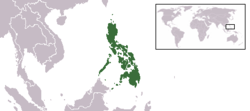
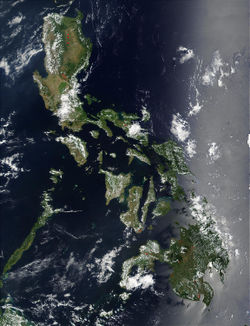
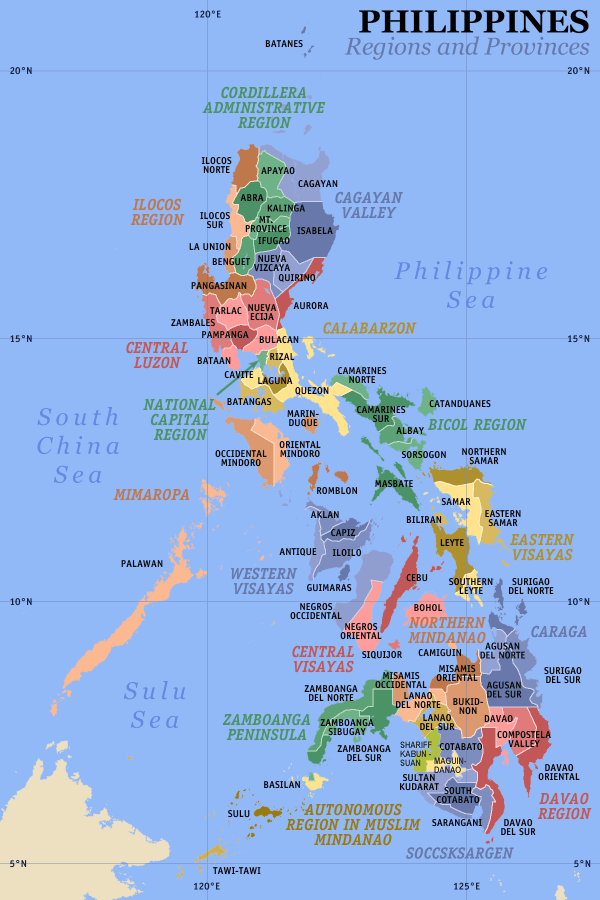
Source ©
Wikipedia |
The Philippines,
officially the Republic of the Philippines, is an archipelagic
nation located in Southeast Asia, with Manila as its capital city.
The Philippine Archipelago comprises 7,107 islands in the western
Pacific Ocean, of which only c. 400 are permanently inhabited.
The Philippines is among the world's most populous
countries. There are more than 11 million overseas Filipinos
worldwide, about 11% of the total population.
The Philippines has
many affinities with the Western world, derived mainly from the
cultures of Spain, Latin America, and the United States. Roman
Catholicism became the predominant religion, although the
pre-Hispanic indigenous religious practices and Islam continue to
flourish.
|
THE CONFLICT AT A GLANCE
The confrontation between Philippine
government and Muslim secessionists on the southern island of Mindanao,
which began in 1969, have caused 120,000 deaths and displaced up to 2
million people.
The Mindanao
conflict is deeply rooted in the colonial
history of the country. Muslims arrived in the
Philippines in the 13th century. Mindanao, the
southernmost of the country's three regions, was
ruled by Muslim sultanates well before Spanish
Christians arrived in the second half of the
16th century, finding strong opposition to their
rule in the Muslim area. When the Philippines passed from
Spanish to American colonial rule at the end of
the Spanish-American War in 1898, large areas of
the Muslim south remained untouched. A process
of forced economic and political integration
started
in the first decades of the 20th century. After
independence, in 1946, the government encouraged Catholic
settlers to move from the north to resource-rich
Mindanao, displacing the comparatively poorer
Muslim communities.
The modern conflict flared at the end of the 1960s when the
Muslim minority - known as the Moros - launched
an armed struggle for their ancestral homeland
in the south of Philippines, the so-called
Bangsamoro.
But over the years, the Moro campaign for
self-rule has become only one of several sources
of bloodshed on Mindanao. These include a long
Maoist insurgency, violence linked to militant
Islamist groups with pan-Asian aspirations,
bloody ethnic vendettas, clan wars and banditry.
In 1996 the government gave predominantly Muslim
areas a low degree of self-rule, setting up the
Autonomous Region in Muslim Mindanao (ARMM),
which was generally considered an insufficient
improvement.
Recently, significant progress
has been made in peace negotiations with the two
main Muslim separatist organisations, the MNFL
and the MILF, but Mindanao and neighbouring
islands remain an attractive refuge for radical
jihadist
groups.
Today more
than 120,000 people remain uprooted by the
fighting, an estimate considered to be
conservative.
Politics and
religion aside, much of the violence is fuelled
by deep poverty rooted in decades of
under-investment.
Today poverty is considered at the same time a
cause and a consequence of the war.
Estimates of economic losses due
to the Mindanao conflict range from P5 billion to P10 billion
annually from 1975 to 2002. |
Politics
The Philippines has a representative democracy modelled on
the US system. The 1987 constitution re-established a presidential
system of government with a bicameral legislature and an independent
judiciary. The president is limited to one six-year term. Provision
also was made in the constitution for autonomous regions in Muslim
areas of Mindanao and in the Cordillera region of northern Luzon,
where many aboriginal tribes still live.
(Source: US Department of State)
The
Philippines is divided into three island groups :
Luzon,
Visayas, and
Mindanao. These are divided into
17 regions,
81 provinces,
131 cities,
1,497 municipalities, and 41,994
barangays.
On
July 24,
2006, the
State of the Nation Address of
President
Arroyo announced the proposal to create five
economic
super regions to concentrate on the economic
strengths in a specific
area.
|
TYPE OF CONFLICT
Secessionist insurgency demanding
the formation of an independent Moro Islamic
state
in
the southern portion of
Mindanao, the
Sulu Archipelago and
Palawan.
Historically, the Moro people had settled the geographical areas we
now describe as Mindanao, the islands of Basilan and Palawan,
and Sulu and Tawi-Tawi archipelago.
Read on
Moro people,
Bangsamoro,
the Sabah
dispute
and the
Autonomous Region in Muslim Mindanao.
FIGHTING FACTIONS FROM LATE 1960s TO 2007
1) Philippines government, led in the last years by President
Gloria Macapagal-Arroyo,
mainly supported by US Army, Christian
militias
and
pro-government Muslim militias.
2) Several Islamic groups acting with separate goals:
Moro National Liberation Front (MNLF)
Moro Islamic Liberation Front (MILF)
Abu Sayyaf (ASG)
Jemaah Islamiyah (JI)
Al
Qaeda-inspired groups (i.e. Rajah Soliman Movement, Abu Sofia, etc.)
«
The first thing we need to do in order to understand the complex
issue involved in the present Mindanao War is to distinguish the
different Muslim actors. This is NOT a popular view, because from
the Presidency to the people in the street, there is a natural
proclivity to adopt a simplistic view of the complex issue and thus
advocate for simplistic solution such as the prevailing "all out
military solution" expressed in various slogans like: "final
solution," "total war,"... »
By this words starts one of the many interesting articles on the
conflict in Mindanao, which explain some aspects of such a complex
matter.
Some articles are available here:
Mindanao Peace process
(1996)
Important Considerations Regarding the War in Mindanao … (2001)
The Mindanao Peace Process
(2004)
Philippines
terrorism: the role of militant Islamic converts
(2005)
“Radical Muslim Terrorism” in the Philippines
(2006)
New People's Army (NPA) is a Maoist paramilitary group
fighting for communist revolution in the Philippines.
Read on
militias
CASUALTIES
According to Reuters AlertNet, an estimated 120,000 have died from
the late 1960s (up to 50% of them were noncombatants) and, time by time, an estimated 2 million people
were internally displaced.
In total, armed incidents have displaced between 119,600 and 139,600
people in Mindanao between January and September 2007
(Internal
Displacement Monitoring Centre).
Read on
internally displaced people
WEAPONS' SUPPLIERS
The Philippines government currently receives arms by USA and South Korea,
according to ARMSFLOW.
Philippine military is accused by observers of igniting the conflict
to promote military demands for updating their weaponry and
equipment. British arms companies were poised to offer war materiel
to the Philippine military.
Read on
guerrilla warfare
and
arms industry
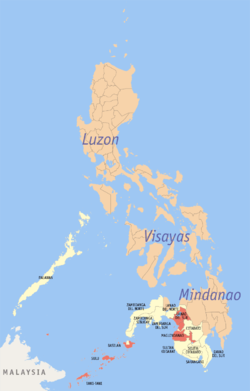 HISTORICAL BACKGROUND HISTORICAL BACKGROUND
The conflict began in the late
1960s when a political organisation called MNLF began fighting for a
Moro Muslim homeland (Bangsamoro),
which includes the southern portion of
Mindanao, the
Sulu Archipelago and
Palawan.
The struggle is rooted to the
conflicts caused by Spanish and US colonisation, beginning in 1521.
However, religion is but one difference, even if a large one,
between the so-called
Moro people
and the rest of
Filipinos. Culture, language, and
tradition are also divisive.
On a larger scale, the Muslim
insurgency in the Philippines is an outgrowth of the division of the
Malay Archipelago by European and American colonial powers. The
colonies that became the nations of
Indonesia,
Philippines,
Malaysia, and
Thailand lumped together and split indigenous peoples of
hundreds of languages and cultures into modern western-like nations,
trying to
assimilate them into "nationalities." There is no doubt that all
of these indigenous groups have suffered immeasurably to avoid
destruction of their culture, language, and livelihood.
At its root, the Moro insurgency is a struggle against the
“historical and systematic marginalization and minoritization of the
Islamized ethno-linguistic groups, collectively called Moros, in
their own homeland in the Mindanao islands”. From 76 percent of the
Mindanao population in 1903, Muslim groups accounted for no more
than 19 percent in 1990.
The conflict might be viewed as a clash between two imagined nations
or nationalisms, Filipino and Moro, each with their own narratives
of the conflict.
Politics, history and religion aside, it must be
said that much of the
present violence is fuelled by deep poverty rooted in decades of
under-investment in the region.
Early history
The
Negritos are believed to have migrated to the Philippines
by land bridges some
30,000 years ago from Borneo, Sumatra, and Malaya. The Malays
followed in successive waves. These people belonged to a primitive
epoch of Malayan culture, which has apparently survived to this day
among certain groups such as the Igorots. The Malayan tribes that
came later had more highly developed material cultures.
The term Negrito refers to a small-statured,
dwindling ethnic group which is now restricted to isolated parts of
Southeast Asia. Negritos are arguably the most enigmatic people
on our planet as they belong to an ancient stratum of
Homo sapiens in Asia. No other living human population has
experienced such long-lasting isolation from contact with other
groups.
[1] Their current populations include the
Aeta,
Ati and at least 25 other tribes of the
Philippines, the
Semang of the
Malay peninsula, the
Mani of
Thailand and 12
Andamanese tribes of the
Andaman Islands.
"Negrito" is the
Spanish diminutive of
negro, i.e. "little black person", referring to their small
stature, and was coined by early European invaders and explorers who
assumed that the Negritos were from Africa. Occasionally, some
Negritos are referred to as
pygmies, bundling them with peoples of similar physical stature
in Central Africa.
The Malay people are believed to have
originated in Borneo and then expanded outwards into Sumatra and
later into the Malay Peninsula.
The social and political organization of the
population, in the widely scattered islands, evolved into a
generally common pattern. Only the permanent-field rice farmers of
northern
Luzon had any concept of territoriality. The basic unit of
settlement was the
barangay, originally a kinship group headed by a
datu (chief). Within the barangay, the broad social divisions
consisted of the maharlika (nobles),
including the datu; timawa (freemen);
and a group described before the Spanish period as dependents.
Dependents included several categories with differing status:
landless agricultural workers; those who had lost freeman status
because of indebtedness or punishment for crime; and alipin
(slaves), most of whom appear to have been war captives.
The Philippines had cultural and trade relations
with India, China, and Islamic merchants as early as the 9th
century.
In the 13th century Arab traders from
Malay, Borneo and the
Indonesian islands started introducing
Islam into the southern islands.
By the 13th century, Islam was established in the
Sulu Archipelago and spread from there to
Mindanao; it had reached the area of modern Manila by 1565.
Although Islam spread as far north as
Luzon, animism was still the religion of the
majority of the Philippine islands. Muslim immigrants introduced a
political concept of territorial states ruled by
rajas or
sultans who exercised
suzerainty over the datu. Neither the political state concept of
the Muslim rulers nor the limited territorial concept of the
sedentary rice farmers of Luzon, however, spread beyond the areas
where they originated.
Before the arrival of the Spanish colonialists
the
Bangsamoro
was already in the process of state formation and governance. In the
middle of the 15th century Sultan Shariff ul-Hashim
established the Sulu Sultanate followed by the establishment of the
Magindanaw Sultanate in the early part of the 16th century by
Shariff Muhammad Kabungsuwan. Their experience on state formation
continued with the establishment of the Sultanate of Buayan, the Pat
a Pangampong ko Ranao (Confederation of the Four Lake-based
Emirates) and other political institutions. These states were
already engaged in trade and diplomatic relations with other
countries, including China. Administrative and political systems
based on the realities of the time existed in those states. In fact,
it was with the existence of this well-organized administrative and
political system that the Bangsamoro people managed to survive the
military campaigns against them by Western colonial powers for
several centuries and preserve their identity as a political and
social entity.
When the
Spanish arrived in the 16th century, an estimated 500,000 people
lived in the Philippines area.
The first Europeans to visit (1521) the
Philippines were those in the Spanish expedition around the world
led by the Portuguese explorer Ferdinand Magellan. Other Spanish
expeditions followed, including one from New Spain (Mexico) under
López de Villalobos, who in 1542 named the islands for the infante
Philip, later Philip II.
Spanish
colonisation
The conquest of the Filipinos by Spain did not begin in earnest
until 1564, when another expedition from New Spain, commanded by
Miguel López de Legazpi, arrived. Spanish leadership was soon
established by violence and destruction over many small independent
communities that previously had known no central rule.
By 1571, López de Legazpi
established the Spanish city of Manila on the site of a Moro town he
had conquered the year before to the
Tagalog
Muslim king,
Rajah Suliman. Then
the Spanish foothold in the
Philippines was secure, despite the opposition of the Portuguese,
who were eager to maintain their monopoly on the trade of East Asia.
Manila repulsed the attack of the Chinese
pirate Limahong in 1574. For centuries before the Spanish arrived
the Chinese had traded with the Filipinos, but evidently none had
settled permanently in the islands until after the conquest. Chinese
trade and labor were of great importance in the early development of
the Spanish colony, but the Chinese came to be feared and hated
because of their increasing numbers, and in 1603 the Spanish
murdered thousands of them (later, there were lesser massacres of
the Chinese).
The Spanish governor, made a Viceroy in 1589, ruled with the advice
of the powerful royal audiencia. There were frequent uprisings by
the Filipinos, who resented the encomienda system.
The encomienda system was a
trusteeship labor system employed by the Spanish crown during
the
Spanish colonization of the Americas and the
Philippines in order to consolidate their conquests.
Conquistadors were granted trusteeship over the
indigenous people they conquered, in an expansion of familiar
medieval
feudal institutions. The maximum size of an encomienda was three
hundred Amerindians, although they were usually much smaller. The
encomenderos were similar to feudal lords in that they were entitled
to demand tribute from the people under their care in the form of
specie, kind, or corvee, but differed in that they were not given
juridical authority. In exchange for the right to collect this
tribute, the encomenderos were charged with maintaining order
through an established military and providing instruction in
Catholicism. As European disregard for the Amerindians led to
widespread corruption and abuses, the system that was intended to
assist in the evangelization of the Natives and the establishment of
a stable society became a force for oppression and enslavement.
Although the Crown reserved the right to revoke an encomienda from
the hands of an unjust encomendero, it rarely did.
By the end of the 16th century Manila had become a leading commercial
center of East Asia, carrying on a flourishing trade with China,
India, and the East Indies. The Philippines supplied some wealth
(including gold) to Spain, and the richly laden galleons plying
between the islands and New Spain were often attacked by English
freebooters. There was also trouble from other quarters, and the
period from 1600 to 1663 was marked by continual wars with the
Dutch, who were laying the foundations of their rich empire in the
East Indies, and with Moro pirates. One of the most difficult
problems the Spanish faced was the subjugation of the Moros.
Intermittent campaigns were conducted against them but without
conclusive results until the middle of the 19th cent.
The term “Moro” was the appellation
applied to all the Muslim population of Southeast Asia by the
Portuguese who seized Melaka in 1511. The Moros are today a
multilingual ethnic group and they mostly live in a region dubbed as
Bangsamoro in the southern Philippines. Bangsamoro was
originally home to the Muslim sultanates of Mindanao (such as
Maguindanao and
Sulu).
Although
Spain claimed the territories of Moros prior to the
Spanish-American War, the Spanish had little actual control over the
area. The staunchly Muslim sultanates of the Sulus and Mindanao
fiercely resisted
Spanish colonial rule and consequent attempts at forcible
conversion to
Catholicism, and were therefore not fully integrated with the
rest of the islands. In the face of this stiff resistance, the
Spanish were restricted to a handful of coastal garrisons, and they
made only occasional punitive expeditions into the interior. After a
series of less-than-successful attempts during the centuries of
Spanish rule in the Philippines, Spanish forces captured the city of
Jolo, the seat of the
Sultan of Sulu, in 1876. The Spanish and the Sultan of Sulu
signed the Spanish Treaty of Peace on July 22, 1878. Control of the
Sulus outside of the Spanish garrisons was left in the hands of the
Sultan. The treaty had translation errors: According to the Spanish
language version, Spain had complete sovereignty over the Sulus,
while the
Tausug version described a
protectorate instead of an outright
dependency.
As the power of
the Spanish Empire waned, the Jesuit orders became more influential
in the Philippines and acquired great amounts of property, while the
sultanate was taken by internal struggles and international claims,
aiming to keep as much power as possible more than to protect the
people.
The power of
the clergy together Spanish injustices, bigotry, and economic
oppressions fed
the rising sentiment for independence, greatly inspired by the
brilliant writings of
José Rizal.
José Rizal is
considered a national hero and the anniversary of Rizal's
death is commemorated as a Philippine holiday called Rizal Day.
He was a member of a wealthy mestizo family but he felt limited by
Spanish insistence on promoting only "pure-blooded" Spaniards. He
began his political career at the University of Madrid in 1882 where
he became the leader of Filipino students there. For the next ten
years he traveled in Europe and wrote several novels considered
seditious by Filipino and Church authorities. He returned to Manila
in 1892 and founded
La Liga
Filipina, a political group dedicated to peacefully unite the whole archipelago into one vigorous and homogenous
organization. He was
rapidly exiled to Mindanao. During his absence,
Andrés Bonifacio
and other members of the Liga
founded the revolutionary organization
Katipunan,
dedicated to the violent overthrow of Spanish rule. When the
Philippine Revolution started on August 26, 1896, Rizal was
convicted of rebellion, sedition and of forming illegal association,
condemned and shot dead at Bagumbayan Field.
Andrés Bonifacio y de Castro is regarded as the "Father of
the Philippine Revolution" and one of the most influential national
heroes of his country, eventually given the title of Supremo..
Born to a Tagalog father and a Spanish mestiza mother, he was a
clerk before becoming a nationalist leader and poet.
Just before the Revolution broke out, he formed a revolutionary
government called "Republika ng mga Katagalugan" with himself as the
president. But his personal campaigns were less than successful; he
lost all his battles and all led to heavy casualties and massacres.
The revolutionaries, led by officers coming from the upper classes
as the celebrated
Emilio Aguinaldo, had greater success in
Cavite, temporarily
driving the Spanish out of the area. Thus, they sent out a manifesto
calling for a revolutionary government of their own, disregarding
Bonifacio's leadership.
Bonifacio's birthday on November 30 is celebrated as Bonifacio Day
and is a public holiday in the Philippines.
Emilio Aguinaldo y Famy was a Filipino general, politician,
and independence leader, who played an instrumental role in
Philippine independence during the Philippine Revolution against
Spain and the Philippine-American War that resisted American
occupation. In the Philippines, Aguinaldo is considered to be the
country's first and the youngest Philippine President, though his
government failed to obtain any foreign recognition.
The
Philippine Revolution followed the creation of La Liga
Filipina and the Katipunan.
In 1895, Emilio Aguinaldo joined the Katipunan rebellion as a lieutenant
under Gen.
Baldomero Aguinaldo and rose to the rank of general in a few
months. When, in 1896, 30,000 members of the Katipunan launched an attack
against the Spanish colonizers in the same week, only Emilio
Aguinaldo's troops were successfull.
Bonifacio presided over the
Tejeros Convention in Tejeros, Cavite (deep in Aguinaldo
territory) to elect a revolutionary government in place of the
Katipunan on March 22, 1897. Away from his power base, Bonifacio
unexpectedly lost the leadership to Aguinaldo, and was elected instead to the office of Secretary of
the Interior.
Even the election of Bonifacio as Secretary of the Interior was questioned by an Aguinaldo supporter, claiming Bonifacio had not the
necessary schooling for the job. Insulted, Bonifacio
declared the Convention null and void, and sought to
return to his power base in Rizal. Bonifacio was
charged, tried and found guilty of treason (in
absentia) by a Cavite military tribunal. As a
consequense he
was sentenced to death. Aguinaldo's soldiers caught
up with Bonifacio in the town of Indang. They surrounded the house
and asked Bonifacio and his men to disarm and come out peacefully
but Bonifacio refused and violence followed, during which the
Supremo was wounded. Then Aguinaldo confirmed
the death sentence, and the dying Bonifacio was
hauled to the mountains of Maragondon in Cavite, and
executed on May 10, 1897, even as Aguinaldo and his forces were
retreating in the face of government troops augmented by new
recruits from Spain.
The new Spanish Governor-General
Fernando Primo de Rivera declared, "I can take Biak-na-Bato. Any army can capture it. But I cannot
end the rebellion". Then he offered peace to the revolutionaries. Lawyer
Pedro Paterno volunteered as negotiator between
the two sides. For four months, he travelled between
Manila and Biak-na-Bato. His hard work finally bore
fruit when, on December 14-15, 1897, the
Pact of Biak-na-Bato was signed, which specified
that the Spanish would give self-rule to the Philippines within 3
years if Gen. Emilio Aguinaldo was exiled. In accordance with the
pact, Aguinaldo
and twenty five other top officials of the
revolution were banished to
Hong Kong with 400,000 pesos in their pockets,
that they subsequently used to buy weapons to resume the fight,
while the rest of the men got 200,000 pesos.
However, thousands of other Katipuneros continued to fight the
Revolution against Spain for a sovereign nation. Unlike Aguinaldo
who came from a privileged background, the bulk of these fighters
were peasants and workers who were not willing to settle for
'indemnities.'
American
colonisation
On April 25,
1898, war broke out between Spain and the United States, the
so-called
the
Spanish-American War.
The United States relied greatly
on assistance from Filipino revolutionaries led by Emilio Aguinaldo,
who already controlled much of the countryside and had proclaimed a
Philippine republic when American troops arrived in large numbers in
July. Americans negotiated Spain’s surrender of Manila in August, as
the war ended. But, instead of liberating the Philippines from
Spanish domination, the United States chose to annex the islands and
begin building an American empire.
Following declaration of war,
Commodore George Dewey
sailed from Hong Kong with Emilio Aguinaldo on board,
in the hope he would rally Filipinos against the Spanish colonial
government. Fighting began in the
Philippine islands at the Battle of Manila Bay on May 1, where
Commodore Dewey destroyed the Spanish fleet. However, he did not
have enough manpower to capture Manila and so Aguinaldo's guerrillas
made the big job and took control of the
entire island of Luzon, except for the walled city of
Intramuros. On
June 12,
1898, Aguinaldo declared the independence of the Philippines.
Then 15,000 US troops arrived at the end of July. Although a peace
protocol was signed by the two belligerents on August 12, Commodore
Dewey and Maj. Gen. Wesley Merritt, leader of the army troops,
assaulted Manila the very next day, unaware that peace had broken
out, and captured the city.
This battle marked an end of Filipino-American
collaboration, as Filipino forces were prevented from entering the
captured city of Manila, an action which was deeply resented by the
Filipinos and which later led to the
Philippine-American War.
On
June 12, 1898, Filipino revolutionary forces under General
Emilio Aguinaldo proclaimed the sovereignty and independence of the
Philippines from the colonial rule of Spain. The formal
Philippine Declaration of Independence proclamed by the
Dictatorial Government of the Philippines of Emilio Aguinaldo
essentially placed the Philippines under the protection of the
United States, so that it was later modified by another
proclamation. The dictatorial government then in place was replaced
by a revolutionary government headed by Emilio Aguinaldo as
president on June 23, 1898.
The
First Philippine Republic, officially República Filipina was
established on January 23, 1899, with the proclamation of the
Malolos Constitution.
Then Aguinaldo and his men fled to Northern Luzón, trying to resist
the American occupation. The US combined tactics of pacification
and social improvement with brutal military strikes and finally
Aguinaldo was captured on March 23, 1901.
On April 1, 1901, Aguinaldo announced allegiance to the
United States, formally ending the First Republic and the
Philippine-American War, recognizing the sovereignty of the United
States over the Philippines. Some non-organized hostilities
continued anyway until the battle Bud Bagsak in 1913.
The
Treaty of Paris
was signed on December 10, 1898, ending the Spanish-American War only 109
days after the outbreak. Spain ceded to the
US, for $20 million, Cuba, Puerto Rico, the Caroline Islands, Guam
and the entire Philippines, despite the controversial
situation created in 1878 with the Sultan of Sulu concerning
protectorate or dependency of the Moro territories. Included in this cession were the
territories of Mindanao and Sulu, which actually had not been in
full Spanish control. About two years later, on November 7, 1900,
the US paid an additional $100,000 to Spain to include in the 1898
cession the Sulu islands stretching as far west as Sibutu and
Cagayan de Sulu.
Following the Treaty of Paris, the Americans asked
the Sultan of Sulu, Jamalul Kiram II, to recognize the US in the
place of Spain, and honor the 1878 provisions of the treaty, which
the Sultan had signed with Spain. As first, the Sultan refused,
stating that the US was a different entity. But the Sultan was not
supported by his ruling council and after few months
he had
to concede to the Americans.
In place of the Spanish treaty,
the Sultan presented Brig. General John Bates with a 16-point
proposal.
The proposal allowed the US to fly its flag side by side with the
Sultanate's and required the US to continue monthly payments to
the Sultan and his datus. The US was not to occupy any of the land
without the permission of the Sultan.
The Sultan's proposal was rejected by Bates, because it did not
acknowledge US sovereignty.
Bates then countered with his 15-point proposal, which included the
recognition of US sovereignty over Sulu and its dependencies, the
guarantee of non-interference with Moro religion and customs and a
pledge that the "US will not sell the island of Jolo or any other
island of the Sulu Archipelago to any foreign nation without the
consent of the Sultan."
The sultan resisted Bates's offer for several months, but he could
not get unanimous support from his ruma bichara (ruling council) to
press for his demands to the Americans. Because of this internal
dissension, led by his own prime minister and adviser Hadji Butu and
two of his top ranking datus, Datu Jolkanairn and Datu Kalbi, the
sultan conceded to the Americans. Officially, Hadji Butu cooperated
with the Americans and "advised his people to accept American rule,
for the sake of peace and to prevent unnecessary loss of lives and
property in Sulu" (Senate of the Philippines).
In February 1899, Aguinaldo led a new revolt, this time against US
rule. Defeated on the battlefield, the Filipinos turned to guerrilla
warfare.
On May 19, 1899, while the forces of the First Philippine Republic
under President Emilio Aguinaldo were resisting the
American invaders, two American battalions occupied Jolo. The
following month, on August 20, Hadji Butu, representing Sultan
Jamalul Kiram II, concluded a treaty with General John C. Bates.
According to this so-called “Bates Treaty,” the Sultan of Sulu
recognized American sovereignty and, in return, the United states
recognized the sultanate as an American protectorate and agreed to
respect the Islamic religion and customs (including polygamy and
slavery) of the Taosug people and not to cede or sell Sulu or any
part of it to any foreign country.
This treaty was based on the earlier Spanish treaty, and it retained
the translation error: the English version described a complete
dependency, while the Tausug version described a protectorate.
Article I of the Treaty in the Tausug version states "The support,
aid, and protection of the Jolo Island and Archipelago are in the
American nation," whereas the English version read "The sovereignty
of the United States over the whole Archipelago of Jolo and its
dependencies is declared and acknowledged."
Although the Bates Treaty granted more powers to the Americans than
the original Spanish treaty, the treaty was still criticized in
America for granting too much autonomy to the Sultan, particularly
concerning the practice of slavery.
The Bates Treaty did not last very long. After the US had
completed its goal of suppressing the resistance in northern
Philippines, it unilaterally abrogated the Bates Treaty on March 2,
1904, claiming the Sultan had failed to quell Moro resistance and
that the treaty was a hindrance to the effective colonial
administration of the area. Payments to the Sultan and his datus
were also stopped.
Bates later admitted that the treaty was merely a stop-gap measure,
signed only to buy time the war in the north was ended and more
forces could be brought to bear in the south.
On October 10, 1904,
Hadji Butu
was appointed by the American military authorities as assistant to
the Military Governor of the province.
Subsequently, on June 20, 1913, General John J. Pershing (Military
Governor of the Moro Province) promoted him as Deputy District
Governor of Sulu.
In December, 1915, Hadji Butu was appointed by Governor-General
Francis Burton Harrison as senator, representing the 12st Senatorial
District (Mindanao and Sulu). He was thus the first Muslim to sit in
the Philippine Senate.
Hadji Butu proved to be an able parliamentarian so that he was
re-appointed senator by Governor-General Henry L. Stimson in 1928.
Many Americans strongly opposed this new trend of
imperialism and the annexion of the new territories hardly passed in
the Congress. Then Theodore Roosevelt became the twenty-sixth US
president after the assassination of William McKinley in 1901.
Roosevelt strongly supported American expansionism, and increased
the size of the military to implement it. His policy was epitomized
in the phrase, “Speak softly, but carry a big stick."
On July 4, 1901, President Theodore Roosevelt issued a
proclamation declaring an end to the Philippine Insurrection and a
cessation of hostilities in the Philippines "except in the country
inhabited by the Moro tribes, to which this proclamation does not
apply."
On June 1, 1903, the
Moro Province
was created, which included "all of the territory of the Philippines
lying south of the eighth parallel of latitude, excepting the island
of Palawan and the eastern portion of the northwest peninsula of
Mindanao". English was declared the official language. Six
hundred American teachers were imported aboard the USS Thomas.
Although a Filipino was always appointed chief justice, the majority
of the members of the Supreme Court were Americans. Also, the
Catholic Church was disestablished, and a substantial amount of
church land was purchased and redistributed. Some measures of
Filipino self-rule were allowed, however. The province had a civil government, but many civil
service positions, including the district governors and their
deputies, were held by members of the American military. This system
of combined civil and military administration had several
motivations behind it. One was the continued Moro hostilities.
Another was the Army's experience during the Indian Wars, when it
came into conflict with the civilian
Bureau of Indian Affairs. A third was that the Moros, with
their feudal society, would have no respect for a military leader
who submitted to the authority of a non-combatant.
Although determined to impose direct rule, the US Army moved
cautiously to avoid encouraging widespread Moro opposition. The US
Government preferred that the Army take control without the
bloodshed that had characterized the recently concluded war against
Filipino nationalists. The Philippine Commission announced that the
United States would not interfere with tribal organization and
culture, and US officials made it clear they would not seek to
convert the Moros to Christianity
But the new Governor of the Moro Province,
Major General Leonard Wood, had to face the Moro propensity for blood feuds,
polygamy, and human trafficking. He wanted to bring them the
American "high ideals of civilization" as soon as possible. (Andrew
J. Bacevich,
What happened at Bud Dajo, The Boston Globe, March 12, 2006).
He instituted many reforms:
-
On Woods'
recommendation, the United States unilaterally
abrogated the Bates Treaty, citing continuing
piracy and attacks on American personnel. The
Sultan of Sulu was demoted to a purely religious
office, with no more power than any other datu,
and was provided with a small salary. The United
States assumed direct control over Moroland.
-
Slavery was
abolished. Slave trading and raiding were
repressed, but slaves were left with their
owners. Wood announced that slaves were "at
liberty to go and build homes for themselves
wherever they like[d]," and pledged the
military's protection for any former slaves that
did so. Similar actions had been taken by
individual commanders in the past, but Wood's
edict had the backing of the Moro Council,
giving it more permanent weight.
-
The Cedula
Act of 1903 created an annual registration poll
tax. This registration poll tax was highly
unpopular with the Moros, since they interpreted
it as a form of tribute. According to Hurley,
participation in the Cedula was very low as late
as 1933.
-
The legal
code of Moroland was reformed. Disputes between
Moros and non-Christians had been left to Moro
laws and customs, with Philippine laws only
applying to disputes with Christians. This led
to a double standard, with a Moro who killed a
Christian facing a stiff prison sentence, but
with a Moro who killed another Moro facing only
a maximum fine of 150 pesos. Wood attempted to
codify Moro law, but there was simply too much
variance in laws and customs between the
different tribes and even between neighboring
cottas. Wood placed the Moros underneath the
Philippine criminal code, but actual enforcement
of this proved difficult.
-
Private land
ownership was introduced, in order to help the
Moros transition to a more individualistic
society from their traditional tribal society.
Each family was given 40 acres (16 ha) of land,
with datus given additional land in accordance
with their status. Land sales had to be approved
by the district governments in order to prevent
fraud.
-
An
educational system was established. By June
1904, there were 50 schools with an average
enrollment of 30 students each. Because of
difficulties in getting teachers that spoke
native languages, classes were conducted in
English after initial training in that language.
Many Moros were suspicious of the schools, but
some offered buildings for use as schools.
-
Trade was
encouraged in order to give the Moros an
alternative to fighting. Trade had been
discouraged by banditry, piracy, and the
possibility of inter-tribal disputes between
Moro merchants and local customers. When trading
with foreign merchants, a lack of warehousing
made for a buyer's market, leading to low
prices. Wood handled banditry and piracy by
establishing military posts at river mouths in
order to protect sea and land routes. Starting
with a pilot project in
Zamboanga, a system of Moro Exchanges were
established. These exchanges provided Moro
traders with warehouses and temporary housing in
exchange for honoring a ban on fighting within
the exchange. Bulletin-boards listed market
prices in
Hong Kong and
Singapore, and the district governments
guaranteed fair prices. These Exchanges proved
highly successful and profitable, and provided a
neutral ground for feuding datus to settle their
differences.
Not surprisingly, Wood’s policies met with increased
opposition. The elimination of slavery and the traditional legal
code struck directly at the power of the datus, and some of them
decided to take up arms against the Americans. Other Moros chose to
resist for religious reasons, fearing the Americans would eventually
demand that they convert to Christianity. The Cedula Act also
created intense resentment among many Moros who saw compliance as a
form of tribute to a non-Islamic government.
On the other hand, the cultural difference between Americans and
Moros was too big and the mentality of Indian Wars ("the only
good Indian is a dead Indian", US Gen. Philip Sheridan, 1869)
easily came to Philippines. "Civilize 'em with a Krag" became
a similar catchphrase (the Krag was the rifle used at that time by
the US Army).
The
Moro rebellion
took several forms even if the American occupation forces did not
face a unified insurgency or nationalistic movement, but rather the
forces of individual datus who refused to accept American control as
well as localized popular uprisings.
Some Moros, especially on heavily forested Mindanao, practiced
guerrilla warfare, raiding US encampments for weapons and setting
ambushes on jungle trails. The most unnerving form of Moro
resistance was the juramentado, or suicide attack. A juramentado
attacker would seek to reach paradise by slaying as many
nonbelievers as possible before being killed himself. Such attacks
were not common, but they occurred often enough to keep the
Americans on edge.
The Moro rebellion was an ugly war, poorly armed Moro warriors
against seasoned US Army regulars. The Moro weapon of choice was the
kris, a short sword with a wavy blade; the Americans used
Springfield rifles and field guns. Obviously, the Americans never
lost an engagement. Yet even as they demolished one Moro stronghold
after another and wracked up an impressive body count, the fighting
persisted.
Modern Muslim inhabitants of the southern Philippines see the Moro
Rebellion as one phase of a continuing struggle against non-Muslim
influences, the Spanish, the Americans, and the central government
of the Philippines.
To keep full control of the Moro territory, Wood
engaged in strong military actions against the rebels but the usual
result of the indiscriminate firing by US soldiers was the killing
of women and children and burning houses and crops. Any punitive
expeditions left people without homes or food, children without
parents, clans without leaders, and contributed to the breakdown of
the Moro social order.
A long chain of events brought to the
First Battle of Bud Dajo, in which 790 American troops armed
with artillery and rifles attacked a village of rebels hidden in the
crater of the dormant volcano Bud Dajo, killing 600 up to 1,000 men,
women and children and suffering as many as 18 casualties.
Although the battle was a victory for the American forces, it was
also an unmitigated public relations disaster.
In late 1905, hundreds of Moros-determined to
avoid paying the cedula head tax, which they considered
blasphemous-began, took refuge on the peak of Bud Dajo, a volcanic
crater on the island of Jolo, in the Southern Philippines.
Refusing orders to disperse, they set themselves up as ''patriots".
In response Wood dispatched several battalions of infantry to Bud
Dajo with orders to ''clean it up." On March 5, 1906, the
reinforcements arrived and laid siege to the heights. The next day,
they began shelling the crater with artillery. At daybreak on March
7, the final assault commenced, the Americans working deliberately
along the rim of the crater and firing into the pit. When the
action finally ended some 24 hours later, the extermination of as
many as 1,000 Filipino Muslims had been accomplished. Only six of
them survived in front of 15 to 18 American casualties.
Among the dead laid several hundred women and children.
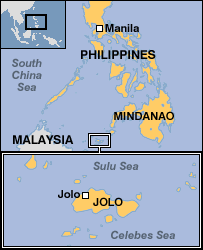 On February 1, 1906, Major Gen.
Tasker H.
Bliss replaced Wood as Governor of Moro Province. He preferred
diplomacy to coercion and opened a "peace era," at the price of
tolerating a certain amount of lawlessness. His new reforms reduced
crime and promote agriculture and trade but law enforcement in the
Moro Province remained difficult.
An elected Filipino
legislature was established in 1907. On February 1, 1906, Major Gen.
Tasker H.
Bliss replaced Wood as Governor of Moro Province. He preferred
diplomacy to coercion and opened a "peace era," at the price of
tolerating a certain amount of lawlessness. His new reforms reduced
crime and promote agriculture and trade but law enforcement in the
Moro Province remained difficult.
An elected Filipino
legislature was established in 1907.
In 1909 Bliss was replaced by Brigadier General
John J.
Pershing, who largely adhered to the policies Bliss had put in place
and didn't practice collective punishment. But his 1911 decision to
disarm the population enraged many Moros and opened a new period of
conflict. In late 1911 about 800 Moros fled to the old battleground
of Bud Dajo to make a stand but Pershing succeeded in dispersing
them ("only" 12 Moro were killed), thanks to a patient approach and
to the cooperation of some Moro leaders.
In 1913 thousands of Moros moved to the fortified crater of
Bud Bagsak in eastern Jolo to defy the disarmament policy. Pershing
tried to negotiate a pacific solution but a group of around 500
remained in their stronghold and refused to surrender their weapons.
Unwilling to accept such open defiance and under pressure to end the
insurgency, Pershing ordered an attack on Bud Bagsak that resulted
in the deaths of almost all the Moros who were there, including as
many as 50 women and children.
During the Moro Rebellion, the Americans suffered clear cut
losses, amounting to 130 killed and 323 wounded. Another 500 or so
died of disease. The Philippine Scouts who augmented American forces
during the campaign suffered 116 killed and 189 wounded. The
Philippine Constabulary, a local police force, suffered heavily
as well, more than 1,500 losses sustained, half of which fatalities.
On the Moro side, losses were remarkably high, with several thousand
killed and wounded. Estimates range from 10,000 to well over 20,000
killed, with an unknown number of wounded. (Wikipedia,
Moro rebellion)
The
battles at places like Bud Dajo and Bud Bagsak long ago faded from
the consciousness of Americans—in fact, they were not much noticed
by Americans even at the time. Among the Moros, however, the US
campaigns were of major importance. The high Moro death tolls
resulting from US military operations contributed to the
development of an anti-US sentiment that continues today. That
sentiment became obvious in February 2003 when the Philippine
Government announced it would participate in Operation Balikatan, a
joint exercise with the United States on Jolo. The government’s
announcement provoked loud condemnations from many Filipinos,
including nationalists who feared the United States would use the
exercise as a way to become directly involved in combat against the
Islamic groups, a role they said the Philippines
Constitution prohibited. Equally significant was the reaction of the
residents of Jolo. A journalist visiting the island shortly after
the announcement reported an outpouring of opposition to the idea of
US troops arriving. A banner in the island’s main port read, “We
will not let history repeat itself! Yankee back off.” The island’s
radio station played traditional ballads with new lyrics: “We heard
the Americans are coming and we are getting ready. We are sharpening
our swords to slaughter them when they come. . . . Our ancestors are
calling for revenge.”25 In the face of growing opposition, the
Philippine Government canceled the exercises on Jolo.26 For the
Moros, whose ballads and storytelling keep events of the past alive,
the US military’s occupation a century before remains a source of
ill will toward the United States.
(Charles Byler, Pacifying the Moros: American Military Government in
the Southern Philippines, 1899-1913 in
http://www.au.af.mil/au/awc/awcgate/milreview/byler.pdf)
When Woodrow Wilson became US
President in 1913, there was a major change in official
American policy concerning the Philippines. While the previous
Republican administrations had predicted the Philippines as a
perpetual American colony, the Wilson administration decided to
start a process that would slowly lead to Philippine independence.
US administration of the Philippines was declared to be temporary
and aimed to develop institutions that would permit and encourage
the eventual establishment of a free and democratic government.
Therefore, US officials concentrated on the creation of such
practical supports for democratic government as public education and
a sound legal system. The Philippines were granted free trade
status, with the US
The question of Philippine independence remained a burning issue
in the politics of both the United States and the islands. The
matter was complicated by the growing economic ties between the two
countries. Although comparatively little American capital was
invested in island industries, US trade bulked larger and larger
until the Philippines became almost entirely dependent upon the
American market. Free trade, established by an act of 1909, was
expanded in 1913.
After 1913, civilians replaced
US Army officers in positions in the provincial government, and
most US soldiers withdrew. Fighting between Moros and government
forces virtually ceased, in part because the disarmament policy had
removed thousands of weapons from the province. Perhaps more
important, the Moros became more supportive of US rule as the
prospects for independence for the Philippines increased; they
realized that independence would probably mean their lands would
fall under the control of the hated Christian Filipinos.
When the US Government promised to grant independence to the
Philippines, the Bangsamoro leaders registered their strong
objection to be part of the Philippine Republic. In the petition to
the US President dated June 9, 1921, the people of the Sulu
archipelago said that they would prefer being part of the US
rather than to be included in an independent Philippine nation (See
Appendix C, Jubair 1999). Bangsamoro leaders meeting in Zamboanga on
February 1, 1924, proposed in their Declaration of Rights and
Purposes that the "Islands of Mindanao and Sulu, and the Island of
Palawan be made an unorganized territory of the United States of
America" in anticipation that in the event the US would decolonize
its colonies and other non-self governing territories the Bangsamoro
homeland would be granted separate independence.
Pershing was replaced as governor of Moro Province by a civilian,
Frank Carpenter.
Though the bloody campaigns against the Moros
officially ended in 1915, US troops continued to encounter
sporadic Moro attacks for the next two decades.
Governor Frank Carpenter asked the Sultan, his heirs, and his
council to sign another agreement with the US on March 22, 1915,
asking the Sultan and his heirs to abdicate their claims to the
throne. Implementation of the 1915 Agreement was further
delayed by negotiations over what the sultan and his heirs would
receive in exchange for their giving up their temporal powers.
In 1916, the Philippine Autonomy Act, popularly known as the
Jones Law, was passed by the US Congress. The law which served as
the new organic act (or constitution) for the Philippines, stated in
its preamble that the eventual independence of the Philippines would
be American policy, subject to the establishment of a stable
government. The law maintained the Governor General of the
Philippines, appointed by the President of the United States, but
established a bicameral Philippine Legislature to replace the
elected Philippine Assembly (lower house) and appointive Philippine
Commission (upper house) previously in place. The Filipino House of
Representatives would be purely elected, while the new Philippine
Senate would have the majority of its members elected by senatorial
district with senators representing non-Christian areas appointed by
the Governor-General. Elections happened on October 3, 1916.
The negotiations which concluded in May 1919 gave the
sultan a life-time payment of P12,000 per annum and allowed him and
his heirs the usufruct use of public lands. Carpenter was confident
that with the settlement final, the sultan would now cooperate with
the US by fully recognizing US sovereignty over Sulu.
When the Republicans regained power in US in
1921, the trend toward bringing Filipinos into the government
was reversed.
Gen. Leonard Wood, former Governor of the Moro province and
responsible of the
Moro
Crater Massacre,
was appointed governor-general. He largely supplanted Filipino
activities with a semimilitary rule. However, the advent of the
Great Depression in the United States in the 1930s and the first
aggressive moves by Japan in Asia (1931) shifted US sentiment
sharply toward the granting of immediate independence to the
Philippines. Members to the elected Philippine legislature lost no
time in lobbying for immediate and complete independence from the
United States. Several independence missions were sent to
Washington, D.C. A civil service was formed and was regularly taken
over by Filipinos, who had effectively gained control by the end of
World War I.
In 1932, the United States Congress passed the
Hare-Hawes Cutting Act, providing for
complete independence of the islands in 1945 after 10 years of
self-government under US supervision. The bill had been drawn up
with the aid of a commission from the Philippines, but
Manuel L.
Quezon, the leader of the leading Nationalist party, opposed it,
partially because of its threat of American tariffs against
Philippine products but principally because of the provisions
leaving naval bases in US hands. Under Quezon's influence, the
Philippine legislature rejected the bill. closely looks like the
Hare-Hawes Cutting Act, but struck the provisions for American bases
and carried a promise of further study to correct “imperfections or
inequalities.”
Manuel Luis Quezon y Molina (b. August 19, 1878 in Baler, Aurora,
Philippines - d. August 1, 1944 in Saranac Lake, New York, United
States) was the first Filipino president of the Commonwealth of the
Philippines under US occupation rule. He is also considered by
most Filipinos, as the second President, after Emilio Aguinaldo,
whose administration did not receive international recognition at
the time. He has the distinction of being the first Senate President
elected to the presidency, the first president elected through a
national election, and was also the first incumbent to secure
re-election (for a partial second term, later extended, due to
amendments to the 1935 Constitution). He is known as the "Father of
the National Language".
In 1934, the United States Congress finally
passed a new Philippine Independence Act, popularly known as the
Tydings-McDuffie Act. The law provided for the granting of
Philippine independence by 1946. It
closely looked like the Hare-Hawes
Cutting Act, but struck the provisions for American bases and
carried a promise of further study to correct “imperfections or
inequalities.”
On March 18, 1935, an assembly of more than 100 Maranao
leaders passed a strong worded manifesto known as the Dansalan
Declaration addressed to the US President vehemently opposed the
annexation of the Bangsamoro homeland in reaction to the US-backed
convention organized to write the Philippine constitution. But the Philippine legislature ratified the Tydings-McDuffie Act
and the new
constitution, approved by President Roosevelt in March 1935, was
accepted by the majority of Philippine people in a plebiscite two months later.
US rule was accompanied by improvements in the education and
health systems of the Philippines; school enrollment rates
multiplied fivefold. By the 1930s, literacy rates had reached 50%.
Several diseases were virtually eliminated. However, the Philippines
remained economically backward. US trade policies encouraged the
export of cash crops and the importation of manufactured goods;
little industrial development occurred. Meanwhile, landlessness
became a serious problem in rural areas; peasants were often reduced
to the status of serfs.
In September
1935 Manuel L. Quezon won the Philippine's first national
presidential election against Emilio Aguinaldo and Bishop
Gregorio Aglipay. Following a plebiscite, the
Commonwealth
of the Philippines was formally established,
featuring a very strong executive, a unicameral National Assembly,
and a Supreme Court composed entirely of Filipinos for the first
time since 1901. The new government embarked on an ambitious agenda
of establishing the basis for national defense, greater control over
the economy, reforms in education, improvement of transport, the
colonization of the island of Mindanao, and the promotion of local
capital and industrialization. The Commonwealth however, was also
faced with agrarian unrest, an uncertain diplomatic and military
situation in South East Asia, and uncertainty about the level of
United States commitment to the future Republic of the Philippines.
To develop defensive forces against possible aggression,
Gen.
Douglas MacArthur was brought to the islands as military adviser
in 1935, and the following year he became field marshal of the
Commonwealth army.
In 1939-40,
the Philippine Constitution was revised to restore a bicameral
Congress, and permit the reelection of President Quezon, who was
eventually
reelected in November 1941.
During the Commonwealth years, Philippines sent one elected Resident
Commissioner to the United States House of Representatives.
WWII and independence
War came unexpectedly to the
Philippines. On December 8, 1941, just ten hours after the
attack on Pearl Harbor, Japan attacked without warning the defending
Philippine and United States troops (about 80,000 troops, four
fifths of them Filipinos) under the command of General Douglas
MacArthur, which surrendered few months later.
President
Quezon and Vice President
Osmeña left for the United States, where they set up a
government in exile.
José P. Laurel
was instructed to remain in Manila because of his prewar, close
relationship with Japanese officials. Laurel was among the
Commonwealth officials instructed by the Japanese Imperial Army to
form a provisional government.
Japanese troops
attacked the islands in many places and launched a pincer drive on
Manila. Aerial bombardment was followed by landings of ground troops
in Luzon. Under the pressure of superior numbers, the defending
forces withdrew to the Bataan Peninsula and to the island of
Corregidor at the entrance to Manila Bay where they entrenched and
tried to hold until the arrival of reinforcements, meanwhile
guarding the entrance to Manila Bay and denying that important
harbor to the Japanese. But no reinforcements were forthcoming.
Manila, declared an open city to stop its destruction, was occupied
by the Japanese on January 2, 1942.
The Philippine defense continued until the final surrender of United
States-Philippine forces on the Bataan Peninsula in April 1942 and
on Corregidor in May.
Many individual
soldiers refused to surrender, however, and guerrilla resistance,
organized and coordinated by US and Philippine army officers,
continued throughout the Japanese occupation. MacArthur was ordered
out by President Roosevelt and left for Australia on March 11, where
he started to plan for a return to the Philippines.
Most of the
80,000 prisoners of war captured by the Japanese at Bataan were
forced to undertake the notorious Bataan Death March to a prison
camp 105 kilometers to the north. It is estimated that as many as
10,000 men died before reaching their destination.
Japanese
occupation of the Philippines was opposed by such a large-scale
underground and guerrilla activity that, by the end of the war,
Japan controlled only twelve of the forty-eight provinces. The major
element of resistance in the Central Luzon area was furnished by the
Hukbalahap (Hukbo ng Bayan Laban sa mga Hapon, "People's Army
Against the Japanese"), which armed some 30,000 people and extended
their control over much of Luzon.
The Japanese military authorities immediately began organizing a new
government structure in the Philippines. They initially organized a
Council of State through which they directed civil affairs until
October 1943, when they declared the Philippines an independent
republic, headed by President José P. Laurel, former Supreme Court
justice.
In August 1944, President Quezon died.
Vice President Sergio Osmeña became president. Osmeña
returned to the Philippines on October 20, 1944, with the
first liberation forces, which surprised the Japanese by landing at
Leyte, in the heart of the islands, after months of US air strikes
against Mindanao.
The landing was
followed (October 23–26) by the greatest naval engagement in
history, called variously the battle of Leyte Gulf and the second
battle of the Philippine Sea. A great US victory, it effectively
destroyed the Japanese navy and opened the way for the recovery of
all the islands. Luzon was invaded (Jan., 1945), and Manila was
taken in February. On July 5, 1945, MacArthur announced “All the
Philippines are now liberated.” Fighting continued until Japan's
formal surrender on September 2, 1945. The Philippines suffered
great loss of life and monstrous physical destruction by the time
the war was over. An estimated 1 million Filipinos had been killed,
and Manila was extensively damaged. The Japanese had suffered over
425,000 dead in the Philippines.
After signing a peace treaty with Japan, the Philippines eventually
received $800m in reparations payments.
Gen. Douglas
MacArthur ordered Laurel arrested for collaborating with the
Japanese. In 1946 he was charged with 132 counts of treason, but was
never brought to trial due to the general amnesty granted by
President Manuel Roxas in 1948.
The Philippine congress met on June 9, 1945, for the first
time since its election in 1941. It faced huge problems. The land
was destroyed by war, the economy destroyed, the country torn by
political warfare and guerrilla violence. Osmeña’s leadership was
challenged in January 1946 when one wing (now the Liberal party) of
the Nationalist party nominated for president
Manuel Roxas, who
defeated Osmeña in April.
As the US was preparing to give the Philippines
commonwealth status in preparation for its independence in 1946,
some Moro leaders favored integration into the republic but majority
from both Sulu and Mindanao protested the plan to incorporate their
homeland into the Philippine state.
In 1946, contrary to its promise under the Bates Treaty "not
to give or sell Sulu or any part of it to any other nation," the
US incorporated Mindanao and Sulu against the will of the Moro
people into the state today known as the Philippine Republic.
But even after their territories were made part of the Republic of
the Philippines in 1946, the Bangsamoro people continued to assert
their right to independence.
The Republic of the Philippines
Manuel Roxas
became the first president of the Republic of the Philippines when
independence was granted, as scheduled, on July 4, 1946.
But his sudden death by heart attack in April 1948 elevated the vice president,
Elpidio Quirino, to the presidency. In November 1949, in a
bitterly contested election Quirino defeated José P. Laurel to win a
four-year term of his own.
In March, 1947,
the Philippines and the United States signed a military assistance
pact and the Philippines gave the United States a 99-year lease on
designated military, naval, and air bases. At the beginning of 1967
a second agreement reduced that period to 25 years
In foreign
affairs, the Philippines maintained a firm anti-Communist policy and
joined the Southeast Asia Treaty Organization in 1954. There were
difficulties with the United States over American military
installations in the islands, and, despite formal recognition in 1956
of full Philippine sovereignty over these bases, tensions increased
until some of the bases were dismantled in 1959.
At the beginning of 1967 a second agreement reduced that period to
25 years.
After independence, efforts to integrate the Muslims into the new
political order met with stiff resistance. It was unlikely that the
Muslim Filipinos, who have had longer cultural history as Muslims
than the Christian Filipinos as Christian, would surrender their
identity.
The enormous
task of reconstructing the war-torn country was complicated by the
activities in central Luzon of the Communist-dominated Hukbalahap
guerrillas (Huks), who resorted to violence in their
efforts to achieve land reform and gain political power.
The Hukbalahap, commonly known as
Huks, was the military arm of the
Communist Party of the Philippines (PKP), formed in 1942 to
fight the
Japanese Empire's occupation of the Philippines during World War
II. The term is a contraction of the Filipino term "Hukbong
Bayan Laban sa mga Hapon", which means "People's Army Against the
Japanese."
They began as several groups of resistance against the Imperial
Japanese Army, mostly joint by agrarian peasants of Central Luzon.
They aimed to lead the Philippines toward
Marxist ideals and
communist revolution.
After its inception
the group grew quickly and by late summer 1943 claimed to have
20,000 active military fighters and 50,000 more in reserve. Weaponry
was obtained primarily by stealing it from battlefields and downed
planes left behind by the Japanese, Filipinos and Americans.
They fought Japanese troops to rid the country of its imperialist
occupation, worked to subvert the Japanese tax-collection service,
intercepted food and supplies to the Japanese troops, and created a
training school where they taught political theory and military
tactics based on Marxist ideas.
In areas that the group controlled, they set up local governments
and instituted land reforms, dividing up the largest estates equally
among the peasants and often killing the landlords.
After the war, the
Hukbalahaps remained active, although to a lesser extent and with
their power diminished.
Under the leadership of
Luis Taruc and Communist Party General Secretary
Jose Lava,
the Hukbalahap
continued waging guerrilla warfare against the United States and
later against the first independent governments. The Hukbalahap Insurrection (1946-1954) was
their attempt to take over the Philippines, but they were accused to
commit rape, robberies and murders against unarmed civilians.
In 1949, Hukbalahap members ambushed and murdered
Aurora Quezon, Chairman of the Philippine Red Cross and widow of
the Philippines' second president,
Manuel L. Quezon, and several others.
Public sympathies for the movement had been waning due to their
postwar attacks, and what remained evaporated following the Quezon
ambush. Without the protection of local supporters, active "Huk"
resistance was eventually defeated in 1954, after a vigorous attack
promoted by President
Ramón Magsaysay. After four months of negotiations led by
Benigno Aquino, Jr.
Taruc surrendered unconditionally to the government.
The Hukbong
Mapagpalya ng Bayan was again ressurected as Bagong Hukbong
Mapagpalaya ng Bayan during the early 1960s, but the Partido
Komunista ng Pilipinas shifted from the use of armed struggle to
parliamentary struggle.
In November 1953, Ramón Magsaysay had became president of the
country, having defeated Quirino. He had promised sweeping economic
changes, and he did make progress in land reform, opening new
settlements outside crowded Luzon island. His death in an airplane
crash in March 1957 was a serious blow to national morale.
Vice President
Carlos P. Garcia succeeded him and won a full term as
president in the elections of November 1957.
In
June 1959, Philippine opposition to García on issues of
government corruption and anti-Americanism led to the union of the
Liberal and Progressive parties, this one led by Vice President
Diosdado
Macapagal.
In the 1961 elections Macapagal succeeded García as
president. Macapagal’s administration was marked by efforts to
combat the mounting inflation that had plagued the republic since
its birth; by attempted alliances with neighboring countries; and by
the Sabah dispute with Britain
and Malaysia.
Malaysia
vigorously opposed the Philippine's territorial claim, arguing that
a certain Baron de Overbeck had "purchased" Sabah from the sultan of
Sulu before later assigning his rights to the British East India
Company. Malaysia further argued that Sabah had become part of
Malaysian territory when Britain granted independence to the
Federated States of Malaysia. The Philippines, by reply, argued a
case of bad semantics, insisting that in 1876 de Overbeck had only
"leased" Sabah from the Sultan of Sulu. The alleged contract between
de Overbeck and the Sultan of Sulu used, they argued, the word
padjak, a Malay term that could mean either "lease" or "purchase."
From the
official website of the ROYAL HASHEMITE SULTANATE OF SULU AND SABAH
http://www.royalsulu.com/issues.htm
The father of HM Sultan Jamalul Kiram II was HM Sultan Jamalul Ahlam
Kiram (Sultan of Sulu and Sabah 1863 to 1881) leased North Borneo/Sabah
to a British Company represented by the two Dent brothers and
Gustavus Baron von Overbeck in 1878. This 1878 North Borneo Lease
states: “The abovementioned territories are from today truly leased
to Gustavus Baron von Overbeck and to Alfred Dent, Esquire, as
already said, together with their heirs, their associates (company)
and to their successors and assigns for as long as they choose or
desire to use them, but the rights and powers hereby leased shall
not be transferred to another nation, or a company of other
nationality, without the consent of His Majesty’s Government.” Based
on facts, reality and history, His Majesty’s Government or the
Government of the Sultan of Sulu as owner never gave its consent to
the 1963 British transfer of Sabah to Malaysia which means that the
“Lease is breached” and based on point of Law, it can be stated that
Sabah must and should be returned to the Lawful Owner namely to the
Sultan of Sulu. Sabah is the private property of the Sultan of Sulu
up to now and the Sabah occupation of Malaysia is unlawful.
THE CONTEMPORARY CONFLICT
The contemporary armed conflict on the Moro front may be set in
periods as follows, based on qualitative changes in the situation,
key issues, decisions, and developments:
1. Formative Years (1968-72)
2. Early Martial Law and Moro War of Liberation (1972-75)
3. First Peace Negotiations and Tripoli Agreement (1975-77)
4. Rest of the Marcos Regime (1977-86)
5. Aquino Administration (1986-92)
6. Ramos Administration (1992-98)
7. Recent Years: Estrada (1998-2001) and Arroyo Administrations
(2001-present)
In the 1960s the central
government in Manila enforced a "homestead" policy, which propelled
the escalation of Christian migration to Mindanao region. Settlers
from Luzon and Visayas occupied part of the Bangsamoro. Local and
foreign big business obtained titles over the lands.
In
the 1965 elections,
Ferdinand E. Marcos succeeded to the
presidency after defeating Macapagal. He inherited the territorial
dispute over Sabah; in 1968 he approved a congressional bill
annexing Sabah to the Philippines. Malaysia suspended diplomatic
relations and
the matter was referred to the United Nations.
Parallel with diplomatic attempts,
Marcos conceived a plot of establishing a force of commandos to
destabilize Sabah, then ultimately to take advantage of the
instability by either intervening in the island on the pretext of
protecting Filipinos living there, or by "the residents themselves
deciding to secede from Malaysia."
The plot brought to the Operation Merdeka, which ended in March 1968
in the
so-called
Jabidah Massacre, in which from 28 to 64 Filipino Muslim
commandos were gunned down by the military in Corregidor, an island
in the entrance of the Philippines' Manila Bay, because they had refused
to invade Sabah.
The Philippines dropped its claim to Sabah only in 1978.
Marcos could not have chosen a more
auspicious time to try and reclaim Sabah. Malaysia was only a
fledgling state at that point, made even more wobbly by the
secession of Singapore in 1965, two years after its independence
from Britain. Too, Malaysia was embroiled in a border dispute with
powerful Indonesia.
The codename for the
destabilization plan was Operation Merdeka. The plan involved the
recruitment of nearly 200 Tausug and Sama Muslims aged 18 to 30 from
Sulu and Tawi-Tawi and their training in the island-town of Simunul
in Tawi-Tawi. The recruits felt giddy about the promise not only of
a monthly allowance, but also over the prospect of eventually
becoming a member of an elite unit in the Philippine Armed Forces.
That meant, among other benefits, guns, which Muslims regard as very
precious possessions. So from August to December 1967, the young
recruits underwent training in Simunul. The name of the commando
unit was "Jabidah".
On December 30 that year, from 135 to 180 recruits boarded a
Philippine Navy vessel for the island of Corregidor in Luzon for
"specialized training."
This second phase of the training turned mutinous when the recruits
discovered their true mission. It struck the recruits that the plan
would mean not only fighting their brother Muslims in Sabah, but
also possibly killing their own Tausug and Sama relatives living
there. Additionally, the recruits had already begun to feel
disgruntled over the non-payment of the promised P50 monthly
allowance. The recruits then demanded to be returned home.
As Jibin Arula, the sole survivor, later recounted, the plotters led
the trainees out of their Corregidor barracks on the night of March
18, 1968, to a nearby airstrip. There, the plotters mowed the
trainees down with gunfire.
Story from
http://corregidor.org/heritage_battalion/jabidah.html
The Jabidah
Massacre contributed to the rise of various separatist movements:
the Muslim Independence Movement (MIM), Ansar el-Islam, and Union of
Islamic Forces and Organizations. When it became evident to the
Bangsamoro leaders that it would not be possible to regain
independence through political means because of lack of
constitutional mechanism, they organized to pursue their goals
through other means.
In 1969, the Moro National
Liberation Front (MNLF) was founded by a group of educated
young Muslims led by
Nur Misuari,
vowing to separate the islands of Mindanao, Palawan and the Sulu
Archipelago from the country and create an independent
Bangsamoro Republic in
Mindanao. The group regarded the earlier movements as feudal and
oppressive, and employed a Marxist framework to analyze the Muslim
condition and the general Philippine situation.
At that time,
the Moro were already the largest mainly
non-Christian ethnic group in the Philippines, comprising about 5%
of the total Philippine population, making them the sixth largest
ethnic group in the country. They mostly lived in the southern
Philippines in the region called Bangsamoro, a term coming
from the Malay word "bangsa", meaning "nation
or people", and the Spanish word "moro"
referred to the
Moro people, in general. These include the
Tausug, the
Maranao,
Maguindanaoan, and the
Banguingui.
Later on, due to migration, Moro communities began to appear in
major cities like Manila, Cebu and Baguio, but Muslims and Christians
generally remained distinct societies.
On March 29, 1969, the
New
People's Army (NPA) was formed as Maoist a paramilitary
group fighting for communist revolution in the Philippines. The NPA
started a "protracted people's war" as the military wing of the
Communist Party of the Philippines (CPP).
Starting out with 60 fighters and 34 rifles, the NPA quickly spread
throughout the Philippine Islands during the dictatorship of
Ferdinand Marcos. After the declaration of martial law on September
21, 1972 thousands of students came into the ranks.
In
November 1969, Marcos won an unprecedented re-election, easily defeating
Sergio Osmeña Jr., but the election was accompanied by violence and
charges of fraud. He was unable to reduce massive government
corruption or to create economic growth proportional to population
growth.
Civil disorder, student protests and labour strikes started. The
Communist Party of the Philippines formed the New Peoples Army and
and launched a "protracted people's war".
In 1969,
the
continuing need for land reform fostered an uprising in central
Luzon,
in something of a Huk revival,
accompanied by mounting assassinations and acts of terror.
The splinter CPP formed the
New People's Army and launched a
protracted people's war while
Marcos began a major military campaign to subdue the
revolt.
In
January 1970, some 2,000 demonstrators tried to storm Malacañang
Palace, the presidential residence; riots erupted against the US
embassy.
In November 1970, when Pope Paul VI visited Manila, an
attempt was made on his life.
In 1971, at a Liberal party rally, hand grenades were thrown
at the speakers’ platform, and several people were killed.
In these years bad skirmishes happened between
Christian vigilantes called “Ilagas” and Muslim vigilantes called
“Barracudas” and “Blackshirts.” The series of Ilaga and military
atrocities against Muslims in Mindanao from 1970 to 1972
caught international attention and raised concern in the Muslim
world, especially when reported as acts of genocide.
In September 1972, President Marcos declared martial law,
charging that a Communist rebellion threatened. He curtailed press
freedom and other civil liberties; closed down Congress and media
establishments; and ordered the arrest of opposition leaders and
militant activists, including his staunchest critics Senator
Benigno "Ninoy" Aquino Jr..
and Senator Jose Diokno. A curfew was implemented. Political
opponents were given the opportunity to go into exile.
Meanwhile the fighting on Mindanao had spread to the Sulu
Archipelago. By 1973 some 3,000 people had been killed and hundreds
of villages burned.
Immediately after the conflict flared up in Mindanao,
the Organization of Islamic Conference (OIC) took interest in
the resolution of the conflict. The Third Islamic Conference of
Foreign Ministers held in Jeddah, Saudi Arabia from February 29 to
March 4, 1972, decided “to seek the good offices of the Government
of the Philippines to guarantee the safety and property of the
Muslims” as citizens of the country.
In its meeting the following year, the OIC decided to send to
Mindanao a fact finding delegation composed of the foreign ministers
of Libya, Senegal, Somalia and Saudi Arabia. It also urged Indonesia
and Malaysia to exert their good offices to help find solution
within the framework of the Association of Southeast Asian Nations
(ASEAN), of which Philippines was one the founder members.
In 1973, the
1935 constitution was replaced by a new one that provided the
President with absolute direct powers. In July a plebiscite gave Marcos the
right to remain in office beyond the expiration of his term.
Throughout the 1970s
the
economy was robust, with budgetary and trade surpluses. The Gross
National Product rose from P55 billion in 1972 to P193 billion in
1980. Tourism rose from less than 200,000 in previous years to one
million by 1980,
contributing to the economy's growth.
On the other side, poverty and governmental
corruption and nepotism increased, and
Imelda Romualdez Marcos, Ferdinand’s wife, became
more and more influential.
THE TRIPOLI AGREEMENT
On
January 18-19, 1975,
through
the mediation efforts of the OIC, representatives of the Philippine
government (GRP) and the MNLF met in Jeddah, Saudi Arabia.
The meeting was the start of the formal negotiations between the
government and the MNLF, but it did not progress initially because
of serious disagreements on many issues. As an attempt to reconcile
the differences, the OIC put forward a plan of action that called
for the establishment of an autonomous region for the Muslims, at
the same time respecting the territorial integrity and sovereignty
of the Philippines.
Imelda Marcos, invited to visit Libya, was sent as President special
envoy. The visit resulted in the agreement to resume the peace
negotiations. On December 15-23, 1976, the GRP and the MNLF
met in Tripoli, Libya, under the auspices of the OIC. Following the signing of
the 1976 Tripoli Agreement, a formal ceasefire agreement between the GRP forces and the MNLF was concluded on January 20, 1977. The GRP
and MNLF negotiating panels agreed on the establishment of an
autonomous region for the Muslims covering thirteen provinces.
Subsequently, MNLF was accredited by the Organization of the Islamic
Conference (OIC) to represent Moros with an observer status.
The implementation of the Tripoli Agreement was
immediately problematic. The Agreement embodied the general principles
for autonomy and its institutional mechanism that would to be
established. The details were to be discussed later by a mixed
committee composed of the representatives of the government and the MNLF. The mixed committee met in Tripoli in February 1977 but no
agreement on details of the autonomy was reached. Again, President
Marcos sent his wife to Tripoli to meet President
Gaddafi and
exchanges of cables between the two presidents followed.
The two presidents agreed that (1) a decision be issued by the
President of the Philippines declaring autonomy in the thirteen
provinces covered in the Tripoli Agreement; (2) a provisional
government be formed with the participation of the MNLF and the
inhabitants of the areas of autonomy; and (3) a referendum be held
in the areas of autonomy concerning administrative arrangements.
The Gaddafi-Marcos agreement, which was strongly
objected to by the MNLF, became the basis of the government to
unilaterally implement the Tripoli Agreement.
In March 1977, Marcos issued Proclamation 1628, creating two
regional autonomous governments—thereby dividing into two groupings
and reducing by three the 13 provinces under the Tripoli
Agreement—and then subjecting this to a plebiscite in April.
Nur Misuari was invited to chair a provisional government, but he
refused. The referendum was boycotted by the Muslims themselves. The
talks collapsed, and fighting continued.
Since
its first steps, (resolution no. 18/5-P of the 5th ICFM), the
OIC prescribed that the solution to the problem should be “within
the framework of the national sovereignty and territorial integrity
of the Philippines.”
US Assistant Secretary of State James A. Kelly, in a letter to
Chairman Salamat Hashim said that “the United States Government is
committed to the territorial integrity of the Philippines.”
This attitude of the main mediators
caused a
lack of participation of the Bangsamoro people
in the peace process, particularly on matters of vital importance
related to self-determination.
The MNLF made the decision to abandon independence as a goal
in favour of autonomy without previous popular consultation. The consequence
of that was the people’s lack of support for the peace agreement, as
the people perceived it to be a product of betrayal of their
cherished dream. As a consequence, there was shift of support from
the MNLF to other groups that vowed to pursue the goal of independence.
Later on, even the
Abu Sayyaf Group
(ASG), in spite of its terrorist and
criminal activities, received some support from the masses of Basilan and Sulu.
For the period 1969-1976, which included the fiercest fighting
between the government and the MNLF under the Marcos regime, it is
estimated that as many as 60,000 people may have been killed, 54,000
wounded or maimed, and as many as 350,000 displaced.
In 1977, after
Misuari acceded to the wishes of the OIC to drop the Front’s bid for
independence and instead settle for autonomy, a faction lead by
second-in-command
Salamat Hashim broke away from the MNLF and formed the Moro
Islamic Liberation Front (MILF) to continue the struggle to
pursue independence. MILF did not stray far from the philosophical
foundations of MNLF but organized its own political machinery
and armed forces separate from the MNLF. With 15,000 members, it
became the largest Islamic separatist group in the Philippines.
Although the MILF was as strong a force as the MNLF and was dominant
in Bangsamoro areas in mainland Mindanao, the government confined
the negotiations with the MNLF until the peace accord was signed in
1996. Peace overtures with the MILF were limited to informal
contacts. This was so because the MNLF was the signatory to the
Tripoli Agreement, which was the basis of the peace talks. Likewise,
the OIC, under whose auspices the negotiations were carried out,
recognized the MNLF as the representative organization of the
Muslims in South of the Philippines.
On the other hand, the MILF did
not want to complicate the GRP-MNLF peace talks and rejected any
attempt by the Philippine government to open separate negotiations.
In the early 1980s the New
People's Army (NPA) was at its peak with over 25,000 fighters, being
classified as a terrorist organization by the United States and the
European Union
Martial law
remained in force until 1981, when it was officially lifted
in order to appease the Catholic Church before the visit of Pope
John Paul II. An opposition boycotted presidential elections then
ensued and Marcos was re-elected, amid
accusations of electoral fraud.
On August 21, 1983, opposition
leader Benigno Aquino, back to the Philippines after a long period
of exile, was assassinated at Manila airport, which
incited a new, more powerful wave of anti-Marcos dissent. The
opposition united under Aquino's widow,
Corazon Aquino.
In February 1986
Marcos and his opponent, Corazon Aquino, run
for presidential election. After the vote, both declared themselves the
winner, and charges of massive fraud and violence were levelled
against the Marcos faction. Marcos’s domestic and international
support eroded, a peaceful civilian-military uprising, now popularly
called the
1986
EDSA Revolution, forced Marcos into exile and he fled the country with his wife Imelda,
eventually obtaining asylum in the United States.
It is said he had amassed an estimated $10bn fortune, but he died
only 3 years after in Hawaii.
THE
JEDDAH ACCORD
In 1986, after President Corazon Aquino assumed the
presidency, she called for a constitutional
convention to draft a new constitution in 1987.
Her
government faced mounting problems, including coup attempts,
significant economic difficulties, and pressure to rid the
Philippines of the US military presence (the last US bases were
evacuated in 1992).
The government initiated the revival of the peace
talks with MNLF. Government's envoys and MNLF chairman Nur Misuari
met at the OIC headquarters in Jeddah, which resulted in the signing
of the Jeddah Accord on January 3-4, 1987.
The two panels
agreed to continue discussion of the proposal for the grant of full
autonomy. It was also agreed upon that a joint commission, which
would “discuss and draft the mechanism and details of the proposal
for the grant of full autonomy” would be created.
The Accord actually deviated from the Tripoli Agreement by
entertaining an MNLF proposal for full autonomy to Mindanao, Basilan,
Sulu, Tawi-Tawi and Palawan (23 provinces all in all) “subject to
democratic processes.” However, the accord was overtaken in February
1987 by the ratification of the 1987 Philippine Constitution, which
had provisions for an autonomous region in Muslim Mindanao “within
the framework of this Constitution and the national sovereignty, as
well as territorial integrity of the Republic of the Philippines.”
The negotiations were again on track but both parties were not able
to reconcile their different proposals.
The MILF refused to accept the
Accord.
On January 29, 1987, a group of
heavily armed rebels occupied a television station as part of a
series of carefully orchestrated attacks on key military bases and
broadcasting stations, including the Villamor air force base near
Manila airport. It was the fifth uprising following her
controversial election victory in spring 1986.
Following the uprising, Corazon Aquino ordered the arrest of a
number of dissident high ranking army officers involved in the
rebellion. She survived one more coup attempt in 1989, when US jets
assisted Philippine government forces in suppressing the rebellion.
In 1990,
with the new
constitutional mandate, President Aquino proceeded to establish the
partially autonomous region known as the Autonomous Region for Muslim
Mindanao (ARMM).

The Autonomous Region of Muslim Mindanao region was
first created on
August 1,
1989 through Republic Act No. 6734 otherwise
known as the Organic Act in pursuance with a
constitutional mandate to provide for an autonomous
area in Muslim Mindanao. A plebiscite was held in
the provinces of
Basilan,
Cotabato,
Davao del Sur,
Lanao del Norte,
Lanao del Sur,
Maguindanao,
Palawan,
South Cotabato,
Sultan Kudarat,
Sulu,
Tawi-Tawi,
Zamboanga del Norte and
Zamboanga del Sur; and in the
cities of
Cotabato,
Dapitan,
Dipolog,
General Santos,
Iligan,
Marawi,
Pagadian,
Puerto Princesa and
Zamboanga to determine if the residents would
want to be part of the ARMM.
Of the areas where
the plebiscites were held only
Lanao del Sur,
Maguindanao,
Sulu and
Tawi-Tawi voted favorably for inclusion in the
new autonomous region, which was rejected where
Christian residents were predominant. The ARMM was officially
inaugurated on
November 6,
1990 in
Cotabato City, which was designated as its
provisional capital.
Social factors in the early 1990s
contributed against the political autonomy sought by Muslim leaders.
Industrial development and increased migration outside the region
brought new educational demands and new roles for women. These
changes in turn led to greater assimilation and, including
intermarriage.
In 1992, Aquino declined to run for re-election and was
succeeded by her former army Chief General
Fidel V. Ramos. He
immediately launched an economic revitalization plan premised on
three policies: government deregulation, increased private
investment, and political solutions to the continuing insurgencies
within the country.
On January 1, 1993 a new Islamic group was formed
in Johor, Malaysia, by the name of Jemaah Islamiyah (JI), which
means “Islamic Community”. JI had its roots in Darul Islam (meaning
"House of Islam"), a conservative movement born in Indonesia in the
1940s. JI's goal was the creation of an Islamic
state across Southeast Asia to include Singapore, Indonesia,
Malaysia, Brunei, southern Thailand, and southern Philippines.
While Jemaah Islamiyah did not exist as a violently brutal terrorist
entity until 1993, the group began to take shape in
1973, when two Muslim clerics, supporters of Darul Islam
formed a pesantren (Islamic boarding schools) in Solo, Indonesia
called Pondok Ngruki.
Upon the eventual formation of Jemaah Islamiyah (JI) around 1993,
the group actively advocated the use of violence to attain its
goals. By the late 1990s, JI was recruiting and training extremists
for the purpose of terrorist actions in Southeast Asia. Jemaah
Islamiyah has shown the ability and willingness to inflict
significant casualties on innocent civilians (including tourists)
and those they believe to be allied with “Western interests.”
JI was linked to several bombings in 2000.
On October 12, 2002, Jemaah Islamiyah inflicted the horrific
Bali bombings, killing over 200 people.
Jemaah Islamiyah is also suspected of
carrying out the
Zamboanga bombings, the
Rizal Day Bombings, the
2004 Jakarta embassy bombing and the
2005 Bali terrorist bombing.
On October 25, 2002, the Abu Sayyaf Group was put on the
list of entities belonging to or associated with the Al-Qaida
organisation by the the
United Nations Al-Qaida
and Taliban Sanctions Committee established pursuant to
resolution 1267 on 15 October 1999.
In August 2003, JI leader Riduan Isamuddin, called
Hambali,
was captured. His arrest surely damaged the group but JI remained an
active and significant terrorist threat in Southeast Asia, having
been directly and indirectly involved in dozens of bombings in the
southern Philippines, usually in league with the Abu Sayyaf.
Financial links between Jemaah Islamiyah, Abu Sayyaf and al-Qaeda, have been found to exist.
On
December 11, 1994, a bomb exploded on
a Philippines Airlines flight en route from Manila to Tokyo with 292
people on board. One passenger was killed an 10 others injured. The
victims were all Japanese. The
Abu Sayyaf Group
claimed credit for the bombing, even if it is still not sure that the
group was involved.
Anyway that was the first of many attacks to private and public
properties, tourists and authorities claimed by the group.
The Abu Sayyaf Group (ASG) is one of
the smallest (but maybe the strongest) radical Islamic group active
in the Southern Philippines and Malaysia. Its stated goal is the
creation of an independent Islamic state encompassing the Islamic
parts of Southern Thailand, the island of Borneo, the Sulu
Archipelago, and Mindanao, areas where Moro Muslims make up the
majority of the local population.
Abu Sayyaf, which literally means “father of the sword” in Arabic,
was founded in 1991 by
Abdurajik Abubakar Janjalani
and some radical MNLF members who objected to the MNLF’s peace
negotiations with the Philippine government. Janjalani, former
teacher and veteran of war against Soviet Union in Afghanistan, was native of
Isabela City, currently one of the smallest and poorest, or
so-called "5th-class" cities of the Philippines. Though Janjalani’s
first recruits were dissidents from the MNLF, both the MILF and the
MNLF deny having links with Abu Sayyaf because of its attacks on
civilians and its profiteering. Islamic scholars do not support Abu
Sayyaf because their acts violate Islamic values. The Organization
of the Islamic Conference (OIC)
also
does not support Abu Sayyaf for the same reason.
It is generally believed that the group received initial funding and
training from Al Qaeda in the early 1990s through Mohammad Jamal Khalifa, a brother-in-law of Osama bin Laden.
Since then,
Abu Sayyaf has been largely self-financed through extortion rackets
and kidnapping-for-ransom schemes. One report estimated its revenues
from ransom payments in 2000 alone between $10 and $25 million.
According to the US State Department, it may also receive funding
from radical Islamic benefactors. The Philippine government
considers ASG to be allied with the radical Islamic group Jemaah
Islamiyah.
Abu Sayyaf's first large-scale action was the beachhead assault on
the town of Ipil in Mindanao in April 1995.
On December 18, 1998, the founder Abdurajik Janjalani was
killed in a firefight with the Philippine National Police on Basilan
Island. The death of the older brother Janjalani marked a turning
point in ASG operations, shifting from its ideological focus to more
general kidnappings, murders and robberies, as the younger brother
Khadaffy
Janjalani then rose to command.
Since then many consider the group nothing but a criminal racket as
it carried out bombings, kidnappings, assassinations, rapes and
extortion in what they describe as fight for independence.
On October 6, 2001, the Abu Sayyaf Group was put on the
list of entities belonging to or associated with the Al-Qaida
organisation by the the
United Nations
Al-Qaida and Taliban Sanctions Committee established pursuant to
resolution 1267 on 15 October 1999.
On February 27, 2004, an explosive device tore through the
Superferry 14,
killing at least 118 people on the shores outside Manila. This
attack, among many attributed to Abu Sayyaf, was the region's worst
terrorist attack since the 2002 bombing of a Bali nightclub. It was
believed that Abu Sayyaf bombed Superferry 14 because the company
that owned it, WG&A, did not comply with a letter demanding
protection money. Khadaffy
Janjalani and
Abu Sulaiman
were considered the mastermind of the attack.
In September 2006 Janjalani was killed in an
encounter with government troops on September in Sulu Island.
On January 7, 2007, Abu Sulaiman, considered Janjalani's
successor to Abu Sayyaf leadership, was killed in a clash after more
than 7,000 troops had been hunting him for months in a US-backed
campaign called "Oplan Ultimatum."
Abu Sayyaf is believed to receive a small level of
logistical and material support from other extremist groups active
in the region and and to provide safe haven for terrorist leaders
from other groups. It has local infrastructure in place to raise
money. It is also known to have substantial links to factions of the
MILF.
It is thought to have two to five hundred core members mostly
recruited from educational institutions and up to 2000 supporters.
Low numbers indicate a lack of support among the local population.
Their actions are generally fully condemned by the Islamic world as
violating the tenets of Islam.
The US Department of State has branded the
Abu Sayyaf Group
a terrorist entity by adding it to the list of Foreign Terrorist
Organizations.
GRP-MNLF
PEACE AGREEMENT OR JAKARTA ACCORD
Ramos' political program was in part successful,
opening dialogues with the Marxist and Muslim guerrillas. Although
Muslim unrest and violence continued, the
government signed a peace accord with the Moro National Liberation
Front (MNLF) in 1996, which led to an expansion of the
autonomous region in 2001.
It was under the presidency of Fidel V. Ramos that
the final agreement between the government (GRP) and the MNLF was
reached, after three rounds of talks were held in Tripoli and
Jakarta with the active mediation of Indonesia.
On September 2, 1996, in Manila, Ambassador Manuel T. Yan,
Nur Misuari, Ali Alatas and Dr. Hamid Al-Ghabid, representing the
government, MNLF, the OIC Committee of Six, and the OIC Secretariat,
respectively, affixed their signatures to the agreement, which was
the full implementation of the Tripoli Agreement of 1976 and
embodied the totality of all agreements, covenants and understanding
between the government and the MNLF.
The 1996 Peace Agreement was to be
implemented by establishing local governance instruments and
integrating MNLF forces to the Philippines Army and the police
force.
In the meantime, a GRP offer was accepted by
the MNLF for an alliance with the ruling party, enabling the MNLF to
gain control over the existing ARMM through elections held
immediately after in September 1996.
But both parties could not agree on the how and to what extent would
be the implementation of the accord.
The MILF rejected it because it was not a solution to
the Bangsamoro problem, which was in "establishing a system of life
and governance suitable and acceptable to the Bangsamoro people.”.
On
December 3-5, 1996, 1,070,697 delegates allegedly took part
to the First Bangsamoro People's Consultative Assembly (BPCA) held
in Sultan Kudarat, Maguindanao, and called for reestablishment of
the original Bangsamoro state and government.
On September 9, 1996, elections were held for the
ARMM officials. Prof. Nurallaji Misuari, the Chairman of the Moro
National Liberation Front (MNLF), was elected as governor and stayed
in charge
till 2002.
The ARMM elections were considered unique because
they were peaceful, despite being held in what has been the
country's traditionally most volatile areas. After his election as ARMM governor, Misuari promised to use "moral pressure" to convince
members of the Abu Sayaf group and the Moro Islamic Liberation Front
(MILF) to lay down their arms and assist the government in promoting
peace and development in Mindanao.
But in the following years
the MNLF, at least the Nur
Misuari faction, continued to accuse the government of violation and
non-implementation of some provisions of the peace agreement. In
particular they didn't see a clear legislative confirmation of many
of the vital aspects of the Tripoli Agreement like ancestral domain,
territories, development of conflict areas and administrative
system, being the Philippine Congress controlled by members who were
against the very spirit of the agreement. Misuari affirmed that
ARMM as created by the Philippines Congress was not
really equipped to provide meaningful autonomy for the Bangsamoro
people.
On the
other hand, the government maintained that it had faithfully
implemented the accord and
miserably portrayed Nur Misuari as inept and corrupt.
As a matter of fact, ARMM was granted no fiscal autonomy, so money
might come from the national government, which determined how it had
to be spent. Instead, the MNLF wanted the regional government to
determine where the money goes.
The role of the OIC and Libya was helpful in bringing the government
and the MNLF to the negotiation table, and Indonesia was
instrumental in forging the final peace agreement. But in the
implementation stage the OIC, Libya and Indonesia stayed at the
background while the multi-donor agencies took the center stage.
Several
natural disasters, including the 1991 eruption of Mt. Pinatubo on
Luzon and a succession of severe typhoons, slowed the country’s
economic progress in the 1990s. The Philippines, however, escaped
much of the economic turmoil seen in other East Asian nations in
1997 and 1998, in part by following a slower pace of development
imposed by the International Monetary Fund.
Following the signing of the 1996 Peace Accord expectations were
high that the people of Mindanao would enjoy lasting peace. But
subsequent violent clashes between government troops and Moro forces
displaced more than a million civilians and destroyed their
productive assets.
When the Philippine government was sure that final
agreement with the MNLF would be reached, it contacted the MILF to
search for a peaceful and political settlement of the Mindanao
problem.
On August 3, 1996, former Executive Secretary Ruben Torres
met MILF Vice Chairman for Political Affairs Ghadzali Jaafar in
Davao City to enter into formal negotiations.
Vice Chairman Jaafar and Secretary Torres met again on September
9-10 in Cagayan de Oro City. This time the discussions were on
issues concerning cessation of hostilities and the creation of
technical committees from both sides to draw the talking points and
the guidelines of the proposed ceasefire.
The GRP and MILF technical committees met on January 7, 1997.
This meeting marked the beginning of the official negotiations
between the two parties. But before the second meeting was convened,
armed confrontations between the two protagonists erupted in Buldon,
Maguindanao, from January 16 to 27, 1997.
Subsequent meetings of the GRP-MILF Technical
Committees were focused on the cessation of hostilities. Agreements
were mainly on the operational guidelines for the general cessation
of hostilities, administrative procedures, monitoring mechanism and
identification and acknowledgment of MILF positions/camps.
The government and the MILF signed formal ceasefire agreements, on
July 18, 1997.
In
1998, Joseph Estrada, a former movie actor, was
elected president, pledging to help the poor and develop the
country’s agricultural sector.
On August 27, 1998, GRP and MILF signed an agreement that
reiterated the commitment of both parties to pursue the peace
negotiations, to pledge to implement the joint
agreements/arrangements previously signed, and to protect and
respect human rights. Both parties recognized that there would be
lasting peace on Mindanao when there was mutual thrust, justice,
freedom and tolerance for the identity, culture, and ways of life
and aspirations of all the peoples of Mindanao.
Hundreds of thousands of Bangsamoro allegedly
participated in the Rally for Peace and Justice held in Cotabato
City and Davao City on October 23, 1999, in Marawi City on
October 24, 1999 and in Isabela, Basilan on December 7, 1999.
They issued a manifesto stating, "we believe that the only just,
viable and lasting solution to the problem of our turbulent
relationship with the Philippine government is the restoration of
our freedom, liberty and independence which were illegally and
immorally usurped from us, and that we be given a chance to
establish a government in accordance with our political culture,
religious beliefs and social norms."
On May 3, 2000, Abu Sayyaf
guerillas abducted 21 tourists from a beach of Sipadan, Malaysia's
renowned dive resort island, hitting Malaysia's tourism industry.
Two Malaysians were freed early because they were Muslims. Abu
Sayyaf was demanding $2.4 million for the release of the other
hostages which included at least 10 foreigners. The Abu Sayyaf even
demanded the release of various Muslim terrorists including Ramzi
Yousef, convicted of masterminding the bombing the World Trade
Center in New York in 1993.
In April 2001, Abu Sayyaf guerillas abducted for ransom 20 more
tourists from another beach resort in the south of Philippines. An
American man died during a rescue mission by troops in June 2002.
Another American man and several Filipinos were also beheaded by the
Abu Sayyaf militants.
The ceasefire agreement was broken
in
April 2000 when MILF's main base, Camp Abu Bakar, was attacked
by
the
Armed Forces of the Philippines
(AFP) and
fell to the Philippines military.
After twenty months of negotiations
at the technical committees level, the formal negotiation on the
panel level was inaugurated on October 25, 1999 at the Da’wah Center,
Crossing Simuay, Sultan Kudarat, Maguindanao. Then on December 17,
1999 both peace panels met and agreed on the rules and procedures on
the conduct of the formal peace talks. Substantive issues were
tabled for discussion, but these were not tackled seriously because
of reported ceasefire violations in Maguindanao, Cotabato, Sultan
Kudarat and Lanao del Norte provinces.
On the identification and acknowledgment of MILF positions/camps,
out of 46 major and satellite camps submitted by the MILF for
recognition, only Camp Abubakre as-Sidique, Camp Bushra, Camp
Darapanan, Camp Omar, Camp Badre, Camp Rajahmuda and Camp Bilal were
acknowledged. The other 39 camps were scheduled for verification and
acknowledgment.
The peace panels met on April 27, 2000 in Cotabato City and before
midnight signed an Aide Memoire enumerating what steps they would
take to defuse the tensions. At dawn, however, the
Armed Forces of the Philippines
(AFP) launched an
attack against Camp Abubakre, opening the Philippine
Government-initiated all-out war against the MILF
in Central Mindanao, which displaced half a million people.
In response the MILF declared a
jihad against persecution and oppression.
In response to the call of civil society to save the peace process,
a meeting between the two peace panels took place on June 1, 2000,
when the GRP representatives presented a political package as a
government proposal to solve the problem. That was a draft of the amendments to the ARMM Organic Act, which,
earlier, had been rejected by the MNLF. After few days the MILF
central committee decided to withdraw from the talks and disbanded
its negotiating panel.
In
November 2000, Estrada was impeached on charges of graft.
Demonstrations against him mounted and members of his cabinet
resigned, the supreme court stripped him of the presidency, and Vice
President Gloria Macapagal-Arroyo was sworn in as Estrada’s
successor.
Late in
2000, Estrada was accused to have accepted
millions of dollars in payoffs from illegal gambling operations.
Although his support among the poor Filipino majority remained
strong, many political, business, and church leaders called for him
to resign. In November 2000, Estrada was impeached by the house of
representatives on charges of graft, but the senate, controlled by
Estrada’s allies, provoked a crisis when it rejected
examining the president’s bank records. As demonstrations against
Estrada mounted and members of his cabinet resigned, the supreme
court stripped him of the presidency, and Vice President Gloria Macapagal-Arroyo
took the presidency.
Estrada was
indicted on charges of corruption in April, and his supporters
attempted to storm the presidential palace in May.
One year late,
Estrada was charged with plundering more than 80
million dollars from state funds while in office, found guilty. In
2007 he was jailed for life but, shortly afterwards, he won a
presidential pardon.
When Gloria
Macapagal-Arroyo became President, Nur Misuari was ousted by
the "MNLF Council of 15", forced to vacate his chairmanship
of the MNLF and replaced by a senior
official of the MNLF.
Bangsamoro leaders headed by Sultan
Abdul Aziz Guiwan Mastura Kudarat IV of the Sultanate of Magindanaw
meeting in Cotabato City on January 28, 2001 expressed their
strong desire to regain the Bangsamoro independence. The Declaration
of Intent and Manifestation of Direct Political Act they issued
states:
"As sovereign individuals, we believe that the Bangsamoro people's
political life, as matters stand, call for an OIC-sponsored or
UN-supervised referendum in the interest of political justice to
decide once and for all:
- To remain as an autonomous region
- To form a state of federated union
- To become an independent state"
On March 24, 2001, GRP and MILF signed an agreement
for the resumption of the talks, which provided for the resumption of the peace
negotiations to “continue the same from where it had stopped before
April 27, 2000 until they shall have reached a negotiated political
settlement of the Bangsamoro problem.”
The Second Bangsamoro People's Consultative Assembly
held on June 1-3, 2001
held in Sultan Kudarat,
Maguindanao,
allegedly attended by 2,627,345 delegates from all over the
Bangsamoro homeland, including representatives of non-Muslim
indigenous communities, unanimously declared that "the only just,
meaningful, and permanent solution to the Mindanao Problem is the
complete independence of the Bangsamoro people and the territories
they now actually occupy from the Republic of the Philippines."
In its declaration, the Assembly gave the MILF a conditional support
and mandate in negotiating with the government. “(We) are giving our
full support and mandate to the MILF to represent us in … (the)
negotiations… provided, however, that the MILF does not deviate from
our demand for complete independence…. Should the MILF choose to
deviate, these support and mandate are deemed automatically
rescinded and withdrawn.”
In 2001 a new law was passed for
the expansion of the ARMM to include the areas which initially
rejected inclusion and the provinces which were carved from them,
however only
Marawi City and
Basilan with the exception of
Isabela City opted to be integrated in the region.
Finally, ARMM was composed of five provinces and one city namely:
Basilan, Lanao del Sur, Maguindanao, Sulu, Tawi-Tawi and Marawi
City. Cotabato City was the seat of the regional government
Following talks brought to a ceasefire and then to the Tripoli
Agreement on Peace on June 19–22, 2001.
The agreement recognized the distinct identity of the Bangsamoro
people, their inherent right over their ancestral domain and their
fundamental right to determine their future and political status.
A second round of talks in Kuala Lumpur focused on the implementing
guidelines of the ceasefire.
The third round was supposed to tackle the issue of the
rehabilitation of refugees and development of conflict-affected
areas, but the two panels could not agree on the details.
The government and the MILF signed a formal implementing agreement
on August 7, 2001, after the resumption of peace negotiations,
but fighting with fundamentalist Islamic guerrillas continued and
attacks were claimed even under the name MILF.
After
President Gloria Macapagal-Arroyo assumed
office, she sought the assistance of Malaysian Prime Minister
Mahathir Mohammad and Indonesian President Abdul Rahman Wahid to
convince the MILF to go back to the negotiation table. After series
of trips by the Malaysian emissaries, MILF chairman
Salamat Hashim agreed to resume talks
with the government and sent his top deputy, Al-Haj Murad Ebrahim, to Kuala Lumpur to meet
the Philippine Presidential Adviser on the Peace Process Eduardo Ermita. The meeting was kept so secret that even Presidential
Assistant for Mindanao Jesus Dureza, the chairman of the new
Philippine peace panel, was not informed about it. On March 24,
2001, Murad and Ermita signed the agreement for the resumption of
the talks.
The Murad-Ermita agreement provided for the resumption of the peace
negotiations to “continue the same from where it had stopped before
April 27, 2000 until they shall have reached a negotiated political
settlement of the Bangsamoro problem.” It also provided a commitment
“to honor, respect and implement all past agreements and other
supplementary agreements signed by them.” Both parties agreed to
undertake “relief and rehabilitation measures for evacuees, and
joint development projects in the conflict-affected areas.” The MILF
and the GRP committed themselves “to negotiate with sincerity and
mutual trust, justice and freedom, and respect for the identity,
culture and aspirations of all peoples of Mindanao.”
Following the Kuala Lumpur talks, the MILF declared the suspension
of offensive military action (SOMA) against AFP forces on April 3,
2001 to reciprocate the government declaration of suspension of
offensive military operations (SOMO) against MILF forces. Satisfied
that its conditions5 were met, the MILF central committee agreed to
the resumption of the negotiations and reconstituted its negotiating
panel.
Tripoli was chosen as the venue for the resumption of the
negotiations. The meeting on June 19–22, 2001 resulted in the
signing of the Agreement on Peace Between the Government of the
Republic of the Philippines (GRP) and the Moro Islamic Liberation Front
(MILF),
otherwise known as the Tripoli Agreement on Peace of 2001.
The agreement called for the discussion of three issues: 1) security
(ceasefire); 2) rehabilitation and development of conflict-affected
areas; and 3) ancestral domain. The agreement recognized the
distinct identity of the Bangsamoro as a people occupying a definite
territory, referred to in the document as the Bangsamoro homeland,
and the inherent right of the Bangsamoro people over their ancestral
domain. It also acknowledged the fundamental right of the Bangsamoro
people to determine their future and political status, and that,
therefore, the problem was political in nature that needed a
comprehensive, just and lasting political settlement through
negotiations, and that negotiations and peaceful resolution of the
conflict should involve consultations with the Bangsamoro people
free of any imposition. The agreement allowed the evacuees to be
awarded reparations for their properties lost or destroyed by reason
of the conflict. While previous agreements did not mention the
participation of the OIC, this time the MILF and the GRP wanted that
it acted as observer and monitor implementation of all agreements,
not just the ceasefire agreement.
The second round of the resumed talks in Kuala Lumpur focused on the
implementing guidelines of the ceasefire. At the end of the meeting
of the peace panels, agreement on the Implementing Guidelines for
the Security Aspect of the GRP-MILF Tripoli Agreement of Peace of
2001 was signed on August 7, 2001 at Putrajaya, Malaysia.
The third round was supposed to tackle the issue of the
rehabilitation of refugees and development of conflict-affected
areas, but the two panels could not agree on the details. To
preclude the breakdown of the negotiations the GRP panel presented
the Manual of Instruction for the Coordinating Committees on the
Cessation of Hostilities
(CCCH) and Local Monitoring Teams (LMT) for consideration. The
contents of the manual were culled from provisions of previous
agreements. It was signed on October 18, 2001 at Mines Resort,
Selangor, Malaysia.
Then the talks were suspended. Malacañang announced that the
negotiations would still continue through the back channel with
Secretary Norberto Gonzales, the Presidential Assistant on Special
Concerns, in charge of the part of the government.
The
September 11, 2001 terrorist attacks on the World Trade
Center in New York, and the Abu Sayyf abduction of a group of
20 tourists in 2001 that left five hostages dead, including
Americans, pushed the United
States government to provide training and assistance to Philippine
troops fighting the guerrillas.
In
November 2001 there was a MNLF uprising.
Nur Misuari led a raid on a military camp in Jolo, Sulu,
to protest the government’s alleged non-compliance with the Tripoli Agreement.
He was then subsequently incarcerated.
In January 2002 US announced joint exercises
with Filipino military as a new phase in war on international
terrorism.
Operation Enduring Freedom - Philippines
was part of
Operation Enduring Freedom and was classified as part of US
War on Terrorism.
More than 1,200 members
of
United States Special Operations Command, Pacific (SOCPAC)
and its components joined their counterparts from the Southern
Command of the Armed Forces of the Philippines (AFP). The mission
was to advise and assist the AFP to help combat terrorism in the
country. Much of the mission took place on the island of Basilan in
the southern Philippines, a stronghold of the terrorist group Abu
Sayyaf. This deployment of forces was conducted under a Exercise
Balikatan 02-1, which is not to be confused with a much larger
exercise named Balikatan 02-2 which took place in April 2002 and was
purely a training exercise.
Within OEF-Philippines was another project called Operation Smiles,
an extensive program to provide medical care for local civilians of
Basilan where the fighting had occurred. Operation Smiles included
personnel from the Philippine Government as well as the Armed Forces
of the Philippines (AFP), JTF 510 and non governmental
organizations. Among the results of this operation was the creation
of 14 schools, seven clinics, three hospitals, 81 kilometres of road
and over 20 fresh water wells.
A new militant group, the
Rajah Solaiman Movement (RSM), was formally
established in January 2002, apparently to divert military attention
from the Basilan-based Abu Sayyaf.
The RSM was the radical fringe of the Balik-Islam movement,
literally “return to Islam”, which s made up of people who grew up
as Roman Catholics that have since converted to Islam. Members call
themselves “reverts”, not converts, for two reasons. First, they
maintain that all humans are born free of sin into Islam, but,
misled by parents or guardians, may be brought up in other
traditions. When they revert to Islam, they are cleansed of sin.
Secondly, they argue that Islam was the country’s original religion,
whose spread was forcibly reversed by Spanish colonial intervention.
A powerful symbol of this frustrated destiny is Rajah Solaiman,
Muslim overlord of Manila in the 1500s, at the time of the Spanish
conquest.
Filipino workers returning from Saudi Arabia and the Gulf were the
most important source of adherents to RSM for the more ideological
forms of activist Balik-Islam.
RSM was relatively small in size, in spite of this its operations
were large in scale. In 2004 and 2005, members of this new group
took part in two bombings in the capital region that reflected
intertwined relationships between the converts, the ASG who directly
handled them, their Indonesian mentors and the MILF commanders who
sheltered all three groups.
In October 2005,
Ahmed Santos, RSM’s founder and first leader, was
captured by Filipino security forces. Pio de Vera, his deputy, took
his place as the leader of RSM, only to be captured two months
later. Though it remained unclear who was then leading RSM, the
young organization grew quickly and stayed very active.
On May 7, 2002, the parties signed an
agreement that authorized the MILF to determine, lead and manage
rehabilitation and development projects and established that the GRP
would provide reparations for properties lost in the conflict.
The agreement broke down on February 11, 2003,
after large-scale attacks on MILF positions. The government tied up
more than half its armed forces in Mindanao, despite pledges by both
sides that they would negotiate and exercise restraint. More than
1,000 US troops arrived in the southern Philippines to train
Filipino troops on so-called "small unit tactics", ideal for
fighting guerrilla movements.
On February 21, 2003, the US Department of Defense announced
that the US and Philippine forces would conduct combined operations
against the Abu Sayyaf terrorist group in the Southern Philippines.
About 350 US special operations personnel from the Army, Navy and
Air Force joined Philippine soldiers in the Sulu Archipelago.
Another 750 Americans were to provide logistics support from the
headquarters in Zamboanga on Mindanao Island.
At the end, US Military estimated that the number of Abu Sayyaf
Group members on Basilan Island had decreased to approximately 80
from a prior high of 700 or more.
Ties between the US and the Philippines reached a high point in May
2003, when in return for the deployment of troops for the invasion
of Iraq, the US accorded the Philippines the status of major
non-NATO ally.
In March 2003, a powerful bomb exploded at Davao airport, in
the Philippines' second largest city, killing at least 21 people and
injuring 148, CNN reported. An hour after the airport blast, a bomb
exploded at a health center in Tagum City, 50 kilometers north of
Davao, injuring two people. The Philippine government blamed on
rogue MILF elements, though MILF spokesman Eid Kabalu denied
involvement in the airport attack and denounced both blasts.
However, a truce was declared in July 2003. In the same month
some 300 soldiers were involved in a mutiny in Manila that
the government claimed was part of a coup attempt.
Suspended talks resumed
on May 7, 2002 at Putrajaya, Malaysia after months of back channel
contacts. Instead of the Dureza panel representing the government,
Secretary Norberto Gonzales and Secretary Eduardo Ermita were in
Kuala Lumpur talking to the MILF. They signed the version of the
agreement that Secretary Dureza had refused to sign.
The agreement reached by the two parties provided for the respect of
human rights and observance of international humanitarian laws. It
authorized the MILF to determine, lead and manage rehabilitation and
development projects through a project implementing body that it
would organize. The agreement also provided that the GRP would
provide reparations for properties lost in the conflict.
Ancestral domain was the third issue to be discussed but the talks
were not resumed after the May 7 meeting. The attack by government
forces on MILF positions in Pikit and Pagalungan on February 11,
2003, at the time the Muslims were celebrating ‘id el adha (feast of
sacrifice), derailed the resumption of the negotiations. Three
exploratory talks were held to put back the negotiations on track,
but the talks remained suspended.
The MILF insisted that the government should comply with its
commitment made during the exploratory talks that government troops
withdrew from the Boliok complex and criminal charges against MILF
leaders be dropped.
The military confrontations between the AFP and MILF forces in the year 2000
had displaced an estimated 932,000
people.
The 2001 clashes
between the
Armed Forces of the Philippines (AFP) and MNLF in Sulu,
added to AFP pursuit
of the Abu Sayyaf, had dislocated close to 300,000 people.
In February 2003 when government forces attacked MILF
positions in Maguindanao and Cotabato Province, 393,039 people were
displaced from their homes.
Oxfam estimated that 85% of those displaced were Muslims, 17% were Christians
and 7% were non-Muslim indigenous people.
As of 2003, MILF controlled
12,000 men under arms, broken up into small and very mobile
guerrilla units, whose leaders were confined to secret locations.
The MILF had set up checkpoints and even shadow governments in a
number of towns and villages.
Many of their political leaders were former mujahideen, or holy
warriors. In the 1980s they had been backed by US to fight the
Soviet invaders in Afghanistan as volunteers.
The ARMM was supposed to translate into reality the political
empowerment of the Bangsamoro people but it went to paralysis in
front of poverty, lack of basic services and unresponsive
leadership.
The peace accord did not improve the living conditions of the
Bangsamoro people. The area of the ARMM and other conflict-affected
areas remained the poorest provinces in the country. In fact,
according
to the World Bank, the
average income of people in conflict-affected areas declined after
the 1996 peace agreement and many people felt
dramatically below the poverty line.
On May 6, 2003,
in a BBC interview,
Al-Haj Murad Ebrahim,
the MILF Vice Chairman for Military Affairs and Chief of Staff of
the Bangsamoro Islamic Armed Forces (BIAF),
said that Islam inspired the Bangsamoro, movement, but he stressed
that the struggle was really about political and social neglect.
"The Bangsamoro people feel that the Manila government is not doing
much for the benefit of the Moro People. So that even now, the Moro
people still consider Manila as a foreign government, a foreign
colonial government," Al-Haj Murad said. "The problem here in
Mindanao cannot be part of a fight against global terrorism. It is
only a struggle for the aspiration of the Mindanao people."
Mr Murad met with Osama Bin Laden in the 1980s.
MILF admitted to sending around 600 volunteers to
Al-Qaeda training camps in Afghanistan, and that Osama Bin Laden
sent money to the Moro region, though the group denied directly
receiving any of the money.
The MILF even didn't deny that it
welcomed foreign visitors to its camps. But
MILF leaders denied connections with terrorist group Jemaah Islamiyah
(JI) and Al-Qaeda, though
both the US and the Philippines government suspect that members of
the MILF helped train Indonesians connected to Jema'ah Islamiah (JI),
the group accused of carrying out the 2002 Bali bombing.
Read the interview:
http://news.bbc.co.uk/2/hi/asia-pacific/3003809.stm
On
February 2004 peace talks between government and communist rebel
New People's Army started in Norway, to be called off by the rebels
in August, when the government declined a request from the rebels to
convince the United States and other Western European states to
remove the New People's Army (NPA) and its self-exiled
leader, José
María Sison, from terrorist blacklists.
RECENT
STATUS OF FIGHTING
In May
2004, Gloria Macapagal-Arroyo
was elected president in her own right, but the
balloting was marred by violence and irregularities as well as a
tedious vote-counting process that was completed six weeks after the
election.
In July 2004 President Arroyo
decided to withdraw the 51 Philippines troops from Iraq, bowing to
the demands of the Iraqi Islamic Army, which had kidnapped a
Filipino lorry driver. The decision worsened relations between US
and the Philippines but the driver was freed.
A series of four devastating storms during November and
December killed as many as 1,000 in the country’s north and east,
particularly on Luzon.
On
October 10, 2004, the International Monitoring Team (IMT)
was officially deployed in Mindanao with a one year mandate
to
monitor the upholding of a cease fire from both camps, to monitor
the implementation of the agreements signed since 2001 and to ensure
that the peace process progress to the stage of rehabilitation,
reconstruction, and development of the conflict affected areas.
The team was composed of 60 members among which 4 Libyans, 10
Bruneians, and the rest were Malaysians. Upon arrival in Mindanao,
the members were re-grouped and stationed in five areas or sectors
that cover the conflict areas, namely, Iligan City, General Santos
City, Davao City, Zamboanga City, and Cotabato City which served as
its headquarters.
All IMT members were financially sponsored by their respected
governments while operation costs were borne by the Philippine
government.
On December 22, 2004, the MILF and the Philippine government
announced that they had formed a joint organization to clear the
southern Philippines of criminal elements and operatives of two
terrorist organizations, the Abu Sayyaf Group (ASG) and Jemaah
Islamiyah (JI).
In early 2005 heavy fighting broke out on
Mindanao between government forces and a splinter group of MILF
rebels; also a "state of war" was declared by a MNLF splinter group in
Sulu, followed by frontal attacks against AFP fixed positions. The
AFP countered with artillery, aerial bombardment and armored
supported ground troop assaults against MNLF fixed positions in both
the eastern and western fronts in Sulu. The fighting resulted in
hundreds of casualties on both sides while, due to the
pre-evacuation of 70,000 civilians from the battle zones, there were
zero civilian casualties during that ten-day war.
The AFP estimated the force strength of the MNLF in Sulu to be about
1,000 (the MNLF claimed at least twice more than this), while that
of the Abu Sayyaf Group in Sulu to be about 300.
Despite peace negotiations that had appeared to be
fruitful and a two year cease-fire, in January 9, 2005, MILF operatives
attacked government troops in Maguindanao resulting in at least
twenty-three deaths. Led by Abdul Rahman Binago, one or two hundred MILF
guerrillas surrounded the soldiers and were believed to have
executed several wounded. The combined troops of MILF and Abu Sofia
(a small splinter group of the Pentagon Gang allegedly involved in
kidnaps for ransom) were involved in days of fighting, to avenge the
killing of suspected kidnappers by soldiers.
The MILF officially denied authorizing the attack, and said they
were trying to communicate with Binago.
The incident, along with a 2003 bombing at Davao airport, raised
speculation that the peace negotiations might be ineffectual in
bringing peace to Mindanao if the MILF is unable to control its
operatives.
Another
round of peace negotiations between the MILF and the government of
the Philippines to discuss ending the Muslim insurgency began in
mid-April 2005 in Malaysia. Issues to be discussed included
“ancestral domain” and the natural resources present in rebel-held
areas. Negotiators disagreed over the size of the proposed Muslim
homeland.
In July-September 2005 President Arroyo
survived an opposition attempt to impeach her
over allegations of vote-rigging.
In 2005 and 2006 renewed fighting between the
government forces and Abu Sayyaf guerillas allied with the New
People's Army (NPA) hit the south of the Philippines. At the end of
2006 the NPA was estimated to have 7,000 fighters while Abu Sayyaf
had 2,000.
A new round
of fighting occurred from June 28 to July 6, 2006, between
the MILF and armed civilian volunteers (CVOs) under Maguindanao
Province Governor Andal Ampatuan who were backed by Philippine Army
troops.
The fighting began after Governor Ampatuan blamed the
MILF for a June 23 bomb attack on his motorcade, which killed five
in his entourage. The MILF denied responsibility, but Ampatuan sent
police and CVOs to arrest MILF personnel allegedly connected to the
attack. Four thousand families were reported displaced by the
fighting that followed, which was ended by a cease-fire agreement
signed July 10-11.
In August 2006 President Arroyo survived an opposition attempt to impeach her
over allegations of corruption, human rights abuses and election
fraud.
In February
2007 a Government report accused military figures of being
behind the killings of hundreds of mainly left-wing activists since
2001.
STATUS OF FIGHTING AT PRESENT
DAY
In March
2007, the Philippine government offered to grant extensive
self-government rights to Muslim communities in the south, which it had never done in over
three decades of conflict and intermittent negotiations.
In general terms government would treat the proposed Muslim
homeland, whose borders are to be defined, as indigenous land.
Residents would control rights over Mindanao's rich natural
resources and taxation. The central government would keep control of
defence, foreign affairs, the monetary system and the postal system.
In April 2007 Abu Sayyaf
militants beheaded seven Christian road workers in retaliation for
the death of a militant commander, and sent their heads to troops on
the southern Philippine island of Jolo, which had been carrying out
operations against Islamic militants for several months, aided by US
counter-terrorism trainers.
The road workers' employer had refused to pay a ransom.
At that time Abu Sayyaf was the smallest of Muslim rebel groups in
the Philippines, with about 400 members.
On July
12, 2007, in Basilan, a patrol of GRP marines searching for
kidnapped Italian priest, Fr. Giancarlo Bossi, ran into a group of
some 300 MILF armed men. During the clash, 14 marines were killed, 9
other marines were wounded and at least 4 rebels were killed. Later
10 of the marines were beheaded.
Mohagher Iqbal, the chief negotiator for the MILF, later confirmed
MILF being involved in the clash, but denied that it was responsible
for the beheadings or for the kidnapping of the priest. Iqbal said
the marines had attacked one of the group's strongholds, violating a
ceasefire agreement, and that his forces had therefore fought back.
On July 19, 2007, no ransom was paid for the freedom of
Father Giancarlo Bossi. He pointed to members of the notorious Abu
Sayyaf rebel group as his kidnappers. Authorities blamed a renegade
commander of the MILF, which always denied any responsibility.
In Spring 2007 allegedly 140 people were killed
during three months of campaigning for parliamentary and local
elections.
On July 9, 2007, a lower court Judge allowed
jailed MNLF leader Misuari to attend a tripartite meeting in Saudi
Arabia, which aimed to the implementation of the 1996 peace
agreement between the Philippine government and MNLF. Misuari,
however, failed to leave for failure to present a "sovereign
guarantee" to return from the Saudi government. On December 20,
2007, Makati Regional Trial Court denied Misuari's petition for bail
as he remained under house arrest in New Manila, Quezon City.
In August 2007, battles between the Philippine military and
militants on the island of Jolo left at least 26 soldiers and 31
militants dead.
On September 5, 2007, President Gloria Macapagal-Arroyo
signed Amnesty Proclamation 1377 for members of the
Communist Party of the Philippines and its armed wing, the New
People's Army; other communist rebel groups; and their umbrella
organization, the
National Democratic Front.
The amnesty had to be approved by the Congress.
The amnesty would cover the crime of rebellion and all other crimes
"in pursuit of political beliefs," but not including crimes against
chastity, rape, torture, kidnapping for ransom, use and trafficking
of illegal drugs and other crimes for personal ends and violations
of international law or convention and protocols "even if alleged
to have been committed in pursuit of political beliefs".
Active in 69 of 81 Philippine provinces, the communist New People’s
Army rebels have been waging a protracted guerrilla war that has
killed more than 40,000 people and stunted economic growth. The
rebels were supported by rural communities, which also supplied them
with young recruits. Philippine security forces laimed they had
reduced the number of communist rebels to a record low, 5,760
fighters as of 2008, destroying 13 NPA bases in 2007.
In mid-November, 2007 Arroyo created a cabinet-level task
force to end political violence after putting Manila and provinces
north and south of the capital under a state of alert.
In November 2007 renegade soldiers barricaded
themselves in a luxury hotel in Manila after breaking out of court
where they were standing trial for the failed 2003 mutiny, and
called for the overthrow of President Gloria Arroyo "in order to end
her unconstitutional and illegal occupation of the presidency," one
of the leaders, Brig Gen Danilo Lim, wrote. About 1,500 government
troops had surrounded the building before an armoured personnel
carrier smashed through the main entrance. The renegades were all
arrested.
Counting this one, Mrs Arroyo survived at least two coup plots and
three attempts to impeach her during her time in office, by long-standing corruption allegations.
On
February 18, 2008, about 6,000 U.S. soldiers held conventional
and anti-terrorism drills with 2,000 Filipino troops during the
two-week annual Balikatan (shoulder-to-shoulder) exercises in
several areas in the country, including on Jolo.
PEACE PROCESS
At the beginning of 2008, the International Monitoring Team (IMT)
overseeing the ceasefire between soldiers and insurgents in Mindanao
was composed of 41 officers from the Malaysian Defense Forces, the
Royal Malaysian Police, and the Prime Minister’s Department. The
team was supported by 10 military officers from Brunei, 5 from Libya
and 1 expert in "socio-economic monitoring" from Japan.
During its mandate, the IMT members were well supported by the GRP
and MILF in the conduct of their work. They are assured of
cooperation and "free movement" from the soldiers of Armed Forces of
the Philippines and the MILF, the GRP-MILF Coordinating Committee
for the Cessation of Hostilities (CCCH) and Local Monitoring Teams (LMTs)
in its field investigations. Nonetheless, they were escorted by
GRP-MILF security during their activities at all times. In as much
as the IMT wanted to disseminate information and publish its
investigation reports for public interest, it was primarily bound to
submit its reports to the GRP and the MILF Peace Panels. And since
the IMT's creation was hinged on the consent and full cooperation of
the conflict parties, the termination or suspension of their
involvement was dependent on the uncooperative response and
declining relationship between them.
Since the International Monitoring Team arrived in 2004, fighting
between security and rebel forces drastically decreased from 698
armed clashes in 2004 to just 7 incidents in 2007.
The
difficulties of the ongoing GRP-MILF peace negotiations included
intervals of cease fire violations, suspension of peace
negotiations, administrative delays, from the conflict parties and
the third party facilitator as well. The March 2007 governmental offer of self-determination to the Moros
raised hopes for a durable peace deal but negotiations with the MILF
then stalled for about a year over the
issue of boundaries. A breakthrough was announced in November
2007 and in January
2008.
Jesus Dureza, the president's adviser on the peace process, said a
mutually acceptable deal could be reached and sent a copy of the
re-worded agreement on ancestral domain to Malaysia hoping to
schedule a new round of talks by February, but he signalled that the
government would need for congressional approval. On the other hand,
the MILF feared if
any deal was sent to Congress it would be watered down by the
Christian majority, which happened to the 1996 peace agreement with
MNLF. Although President Gloria Macapagal Arroyo repeatedly said she
wanted peace, hawks in her cabinet were opposed to giving large
swathes of land to Muslims and politically powerful Christian clans
in the south opposed a deal, so that many analysts had cast doubt on Manila's willingness
to relinquish full control over one of the most resource-rich parts
of the country.
The
discontent among the Moros became an opportunity for a handful of jihadists, hiding in remote areas in the restive south, to train
fresh recruits for bombing campaigns. While Indonesia had arrested
hundreds of militants allegedly linked to JI, foreign jihadists
continued to operate in the Philippines, training recruits in
bomb-making.
The decades-old conflict has
already killed more than 120,000 people, displaced 2 million and
kept millions more in dire poverty despite their region having
billions of dollars worth of unexplored mineral wealth and fertile
farmlands.
HUMAN RIGHTS
In February 2007 President Gloria Arroyo declared a week-long State
of Emergency in response to alleged coup conspiracies involving
members of the mainstream opposition in "tactical alliance" with
rightists, communist rebels, leftist politicians and members of the
military. Police enforced a ban on public assemblies and raided a
newspaper office, threatening to shut down media outlets that failed
to follow "responsible" reporting guidelines. Scores of people were
arrested or threatened with arrest, particularly members of legal
leftist political parties which were accused by government and
military officials of links with the Communist Party of the
Philippines (CPP) and its armed wing, the New People's Army (NPA).
Dozens were arrested and charged with "rebellion" in the period
following the alleged coup plot, including critics of the
government.
In April 2007, President Arroyo announced the commutation of all
death sentences. At least 1,230 prisoners had been sentenced to
death since 1994. Death sentences were replaced with life
imprisonment without the possibility of parole.
Amid reports of ineffective investigations, and with witnesses and
relatives of the victims too frightened to co-operate with the
police, perpetrators were rarely brought to justice. In May the
authorities set up a special police investigative task force.
However, only a limited number of people were arrested and few cases
were filed in court by the end of the year.
As military operations intensified, there were reports nationwide of
arbitrary detentions, extrajudicial executions, enforced
disappearances, torture and harassment of civilians suspected of
being CPP-NPA supporters.
In October 2007 the Senate amended an Anti-Terrorism Bill, including
by reducing the time suspects could be detained without judicial
authority, and by withdrawing clauses extending law enforcement
powers to the military.
Terror
tactics are no monopoly of insurgents. Government forces have
countenanced and at times even supported, particularly through the
activities of paramilitary and vigilante groups, covert abductions,
“salvagings” and killings of legal personalities suspected of
collaborating or sympathizing with insurgents. For some on the
government side, terror tactics can look like a cheap and convenient
way to resolve certain issues and set up a deterrent without the
inconvenience of going through the legal system. TFDP documented 152
cases of summary executions under the Ramos administration and 28
under Estrada, numbers which on the other hand can be compared with
the estimated 2,500 summary executions under the Marcos regime.
The government is also responsible of carpet-bombing or the use of
antipersonnel land mines, which hit mainly civilians.
Unarmed civilians have become casualties not only because they were
attacked by soldiers, but because of the havoc wrought by the
fighting. Together with the destruction of lives and livelihoods,
war destroyed croplands, forests, water and sanitation systems, and
other key resources that support communities.
DEVELOPMENT
OF THE COUNTRY
The Philippine economy is growing
at its fastest pace in 25 years with real GDP growth expected to
exceed 7% in 2007. Higher government spending contributed to the
economy's acceleration, but consumer spending and large remittances
from the millions of Filipinos who work abroad have played an
increasingly important role in the economy. The economy has averaged
5% real growth since President Macagapal-Arroyo took office in 2001,
reflecting the continued resilience of the service sector, and
improved exports and agricultural output. Nonetheless, it will take
a higher, sustained growth path to make appreciable progress in the
alleviation of poverty given the Philippines' high annual population
growth rate and unequal distribution of income. Macagapal-Arroyo is
also credited with improving the Philippines' fiscal balance by
improving government tax collection efforts and tightening spending.
Manila is now planning to step up a series of privatizations of
large unprofitable public enterprises, especially in the energy
sector, to further close the budget gap and raise capital to help
finance new infrastructure projects. Credit rating agencies have at
times expressed concern about the Philippines' ability to service
its large private and public debt, though central bank reserves
appear adequate and remittance inflows appear stable.
In the meanwhile the economy of Mindanao is growing. It contributes
34 per cent of the country’s total agricultural production; 44 per
cent of domestic food trade; and 13 per cent of its total
manufacturing output.
But the island has got serious environmental problems. Gold miners
poison bodies of water by using mercury to process ores.
Deforestation causes serious flooding in many parts of the island
during the monsoon rains. And the loss of forest cover threatens to
kill off many species, including the world’s largest eagle, the
endangered Philippine eagle.
Estimates of economic losses due
to the Mindanao conflict range from P5 billion to P10 billion
annually from 1975 to 2002.
Read the
Philippine Human Development
Report 2005
MILF-RELATED INFORMATION
WEBSITES
luwaran.com
Bulatlat
LOCAL e-news
The Manila Times
Manila Bulletin
Philippine News
The Daily Tribune
Manila
Standard Today
SOURCES
ABS-CBN
Interactive
Alertnet
Amnesty International
BBCnews
CIA The World Factbook
Columbia Encyclopedia, Sixth Edition. 2001-05
Foreign Policy Association
HIIK - Heidelberg Institute for International
Conflict Research
ICG - International Crisis Group
IRIN - Integrated Regional Information Networks
Library of American Congress
Mindanao State University
MIPT - The Memorial Institute for the Prevention of Terrorism
PeaceReporter
Project Ploughshares
Philippinecountry
PhilippineUpdate.com
Reuters
Senate of the Philippines
Royal Hashemite Sultanate of Sulu & Sabah
SEACSN Bulletin
Swish of the kris - The Story of the Moros online
The Manila Times
UNDP - United Nations Development Programme
US Department of State
Warnews
Wikipedia
up

|

The Philippines has a total population of
91,077,287 as of
July 2007, with a
growth rate of
1.76%. (2,8 million live in the Autonomous Region in Muslim Mindanao,
16 million in all Mindanao island group)
Ethnic groups
2000 census:
Tagalog 28.1
Cebuano 13.1%
Ilocano 9%
Bisaya/Binisaya 7.6%
Hiligaynon
Ilonggo 7.5%
Bikol 6%
Waray 3.4%
other 25.3%
The great majority of the people of the Philippines
belong to the Malay group and are known as Filipinos. Other groups
include the Negritos (negroid pygmies) and the Dumagats (similar to
the Papuans of New Guinea), and there is a small Chinese minority.
Official languages
are
Filipino
(standardized version of
Tagalog) and English
(imposed by the Americans during the colonisation).
More than 180 languages and dialects
are spoken in the archipelago
Religions
About 94% of Filipinos are Christians, where 81%
belong to the
Roman Catholic Church, 2% composed of Protestant churches and
11% either to the
Philippine Independent Church (Aglipayan),
Iglesia ni Cristo and others.
Approximately 5% of Filipinos are
Muslims. Muslim
population among Mindanao island group make up to 20%
Life expectancy is 70.51 years. 65% of the population is up to 14
years old, being the median age less than 23.
Total
literacy rate
(2000 census) is 92.6% (92.5% for males and
92.7% for females).
The Philippines has one of the highest literacy rates in the
developing world.
Demographic data from 2007 CIA World Factbook
Economy:
With
their tropical climate, heavy rainfall, and naturally fertile
volcanic soil, the Philippines are predominantly agricultural. Rice,
corn, and coconuts take up about 80% of all cropland. Fishing is a
common occupation.
The Philippines will need a
higher, sustained growth path to make appreciable progress in the
alleviation of poverty given the Philippines' high annual population
growth rate and unequal distribution of income.
(CIA)
GDP (PPP)(2006 est.)(CIA)
- Total $449.8 billion
- Per capita $5.000
- Grow rate 5.4%
Gini coefficient
46.1 (high)(CIA 2003)
HDI 0.763
(84th) (UNDP 2006)
Poverty
47.5% of the population live on less than $2 per day (UNDP 2006)
36.8% of the
population live below national poverty line (UNDP 2006)
Unemploy-ment rate
7.9%
(2006 est.)(CIA)
Child labour
12% (5-14 year olds) (1999-2005) (UNICEF)
Under-five mortality rate
34‰ (UNDP 2006)
Military ex-penditures
0.9% of GDP (2005)(CIA)
The Armed Forces of the Philippines consists of the Army, Navy and
Air Force. Due to its close relationship with the United States
military establishment, the Armed Forces of the Philippines was in
the past the strongest national defence programme in Asia —
especially in the 1950s and 1960s. The expulsion of US military
presence in 1992, cuts in funding by the Congress of the Philippines
and the nature of Philippine politics has been cited as sources of
decline of the Armed Forces of the Philippines in recent years.
A strong security relationship between USA and the Philippines rests
on the 1952 US-Philippines Mutual Defense Treaty (MDT). In
February 1998, US and Philippine negotiators concluded the
Visiting Forces Agreement (VFA), paving the way for increased
military cooperation under the MDT.
(Wikipedia/US Dep of State)
Sources
CIA Factbook
UNICEF
UNDP
US Dep State

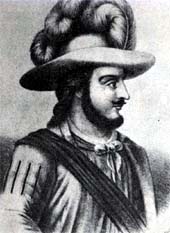
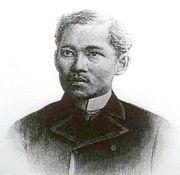
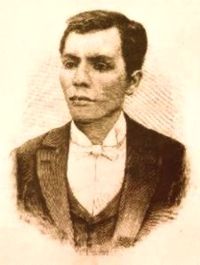
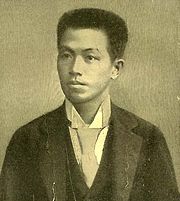

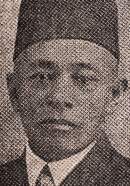
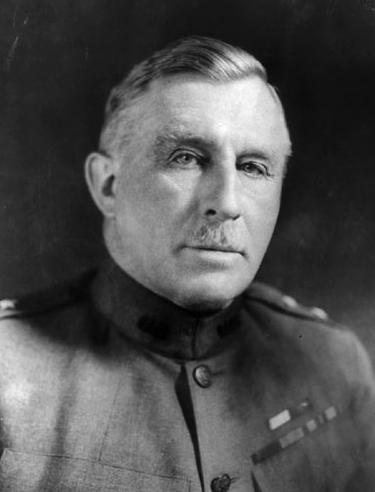
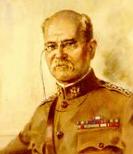
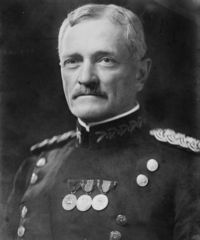
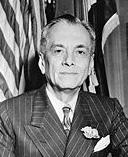

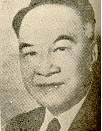
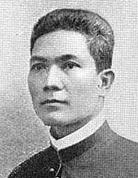
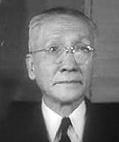
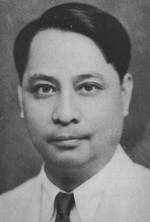
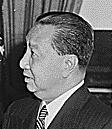

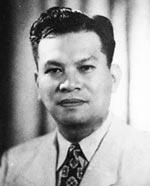
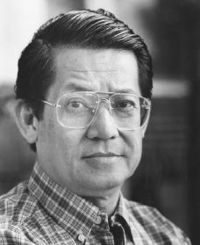

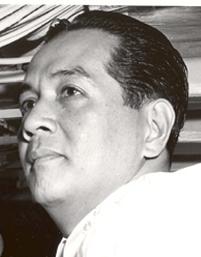
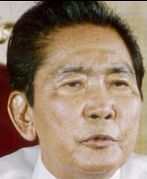
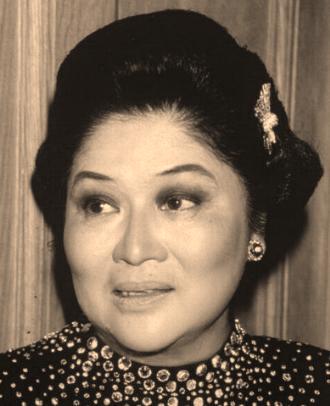
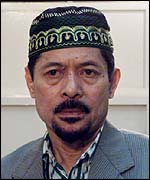

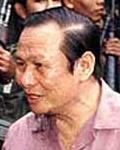
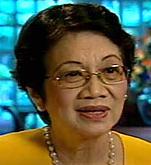
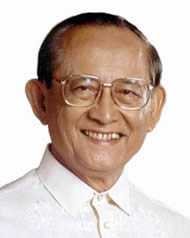
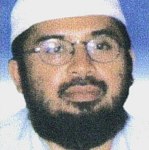

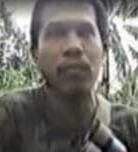
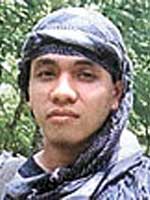
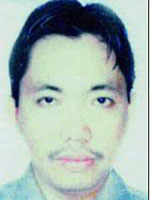
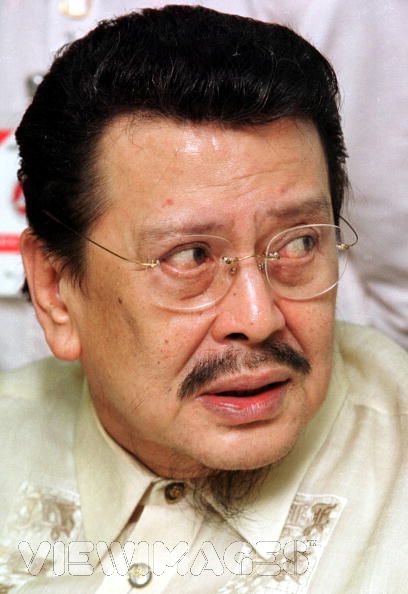
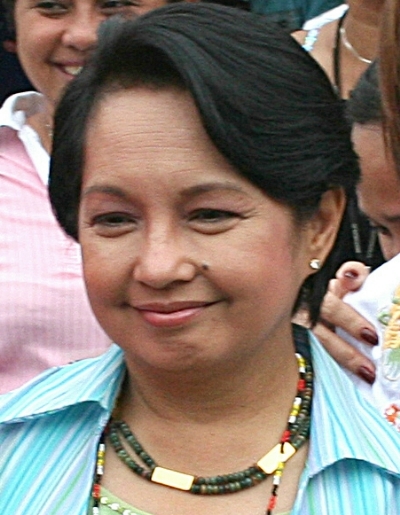
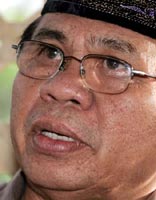
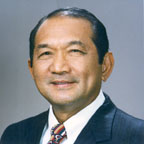
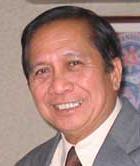
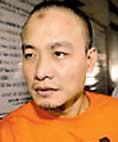
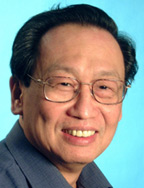 |




 On February 1, 1906, Major Gen.
On February 1, 1906, Major Gen.









































